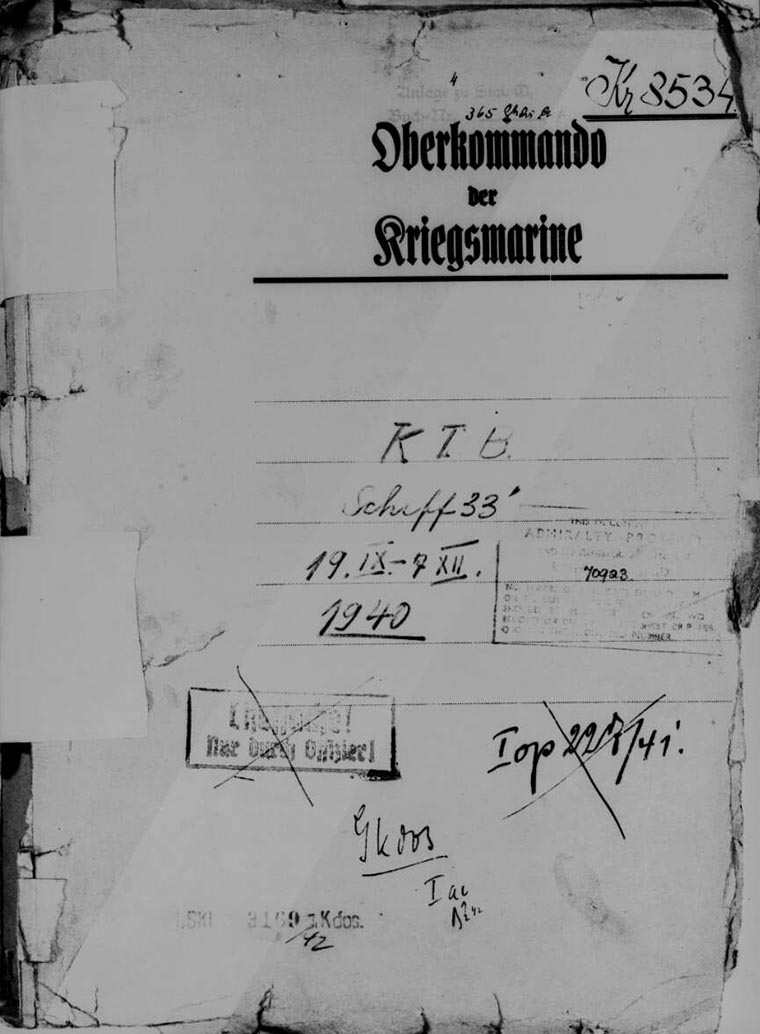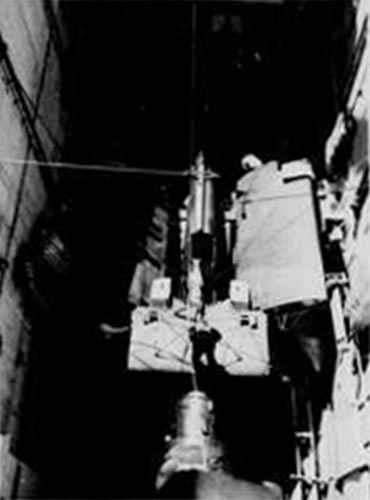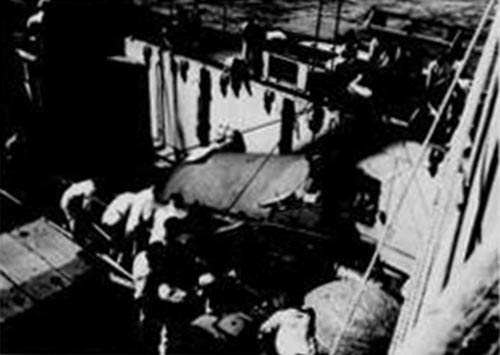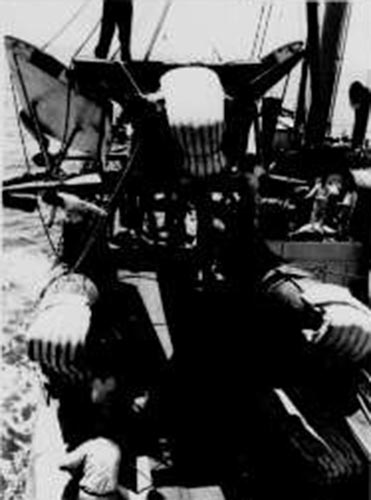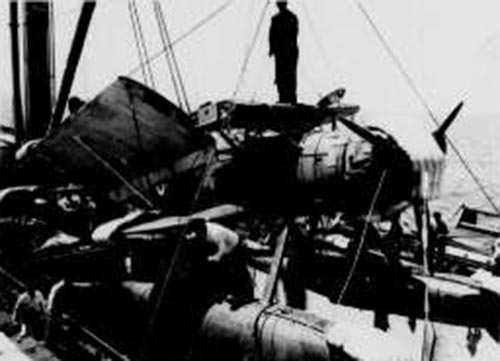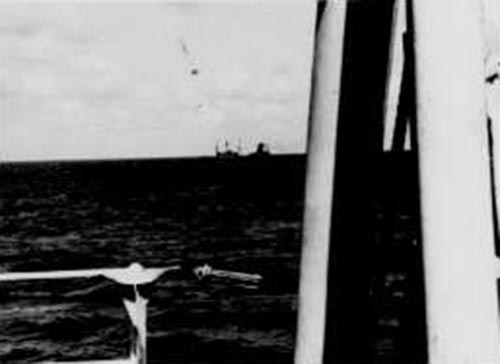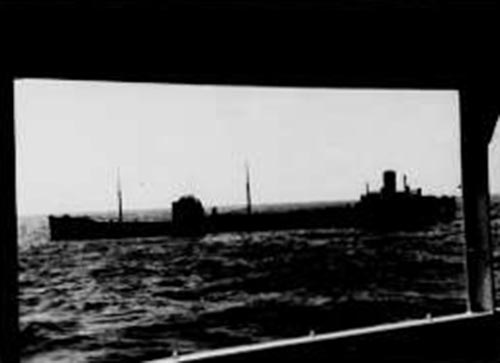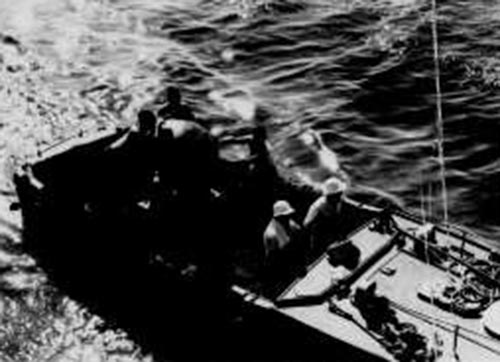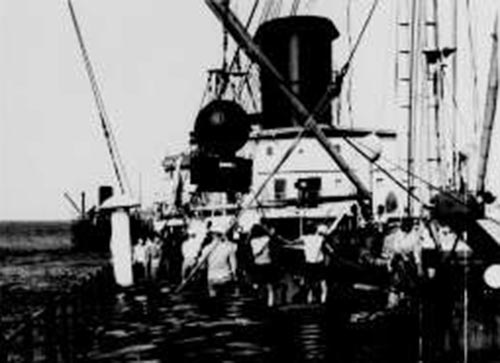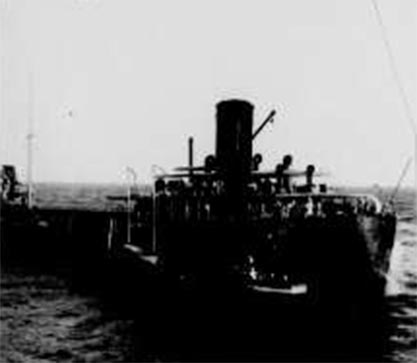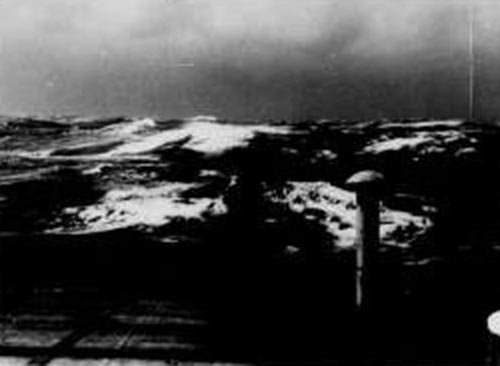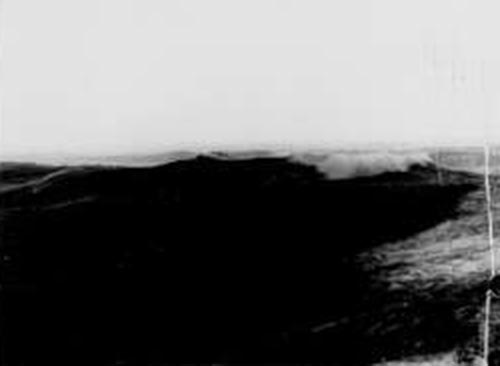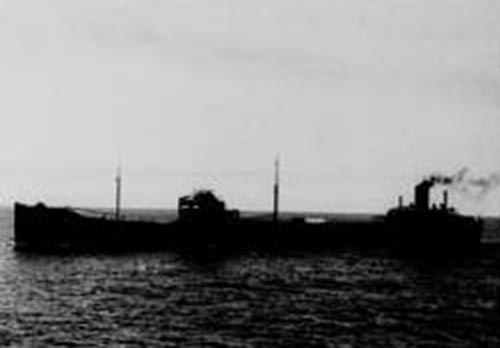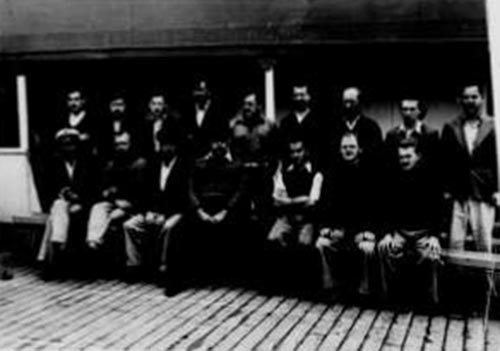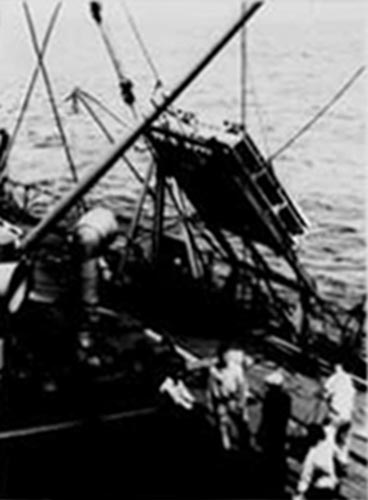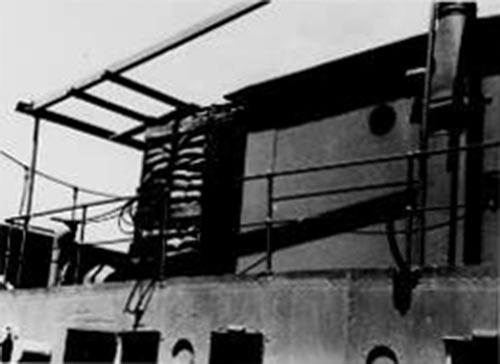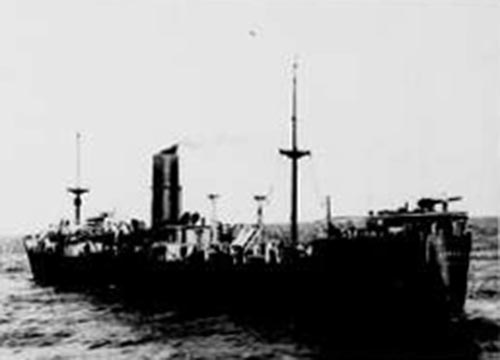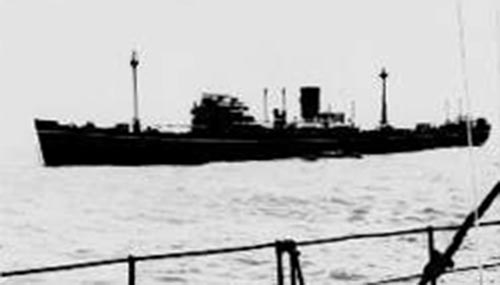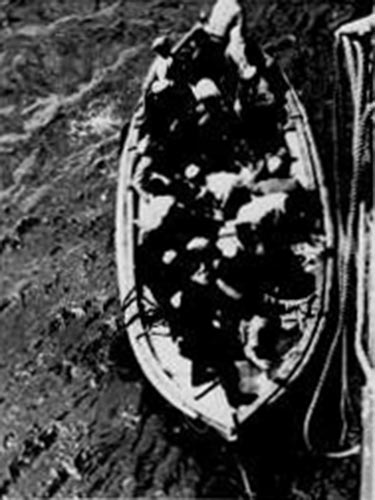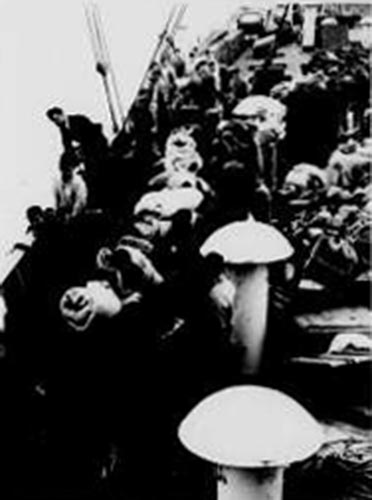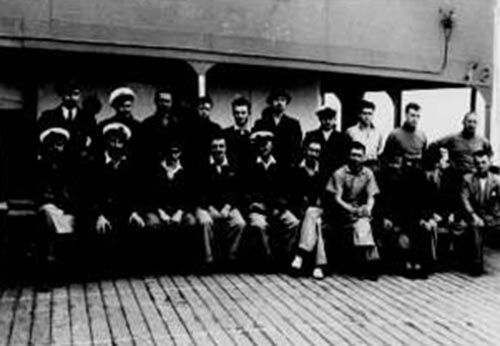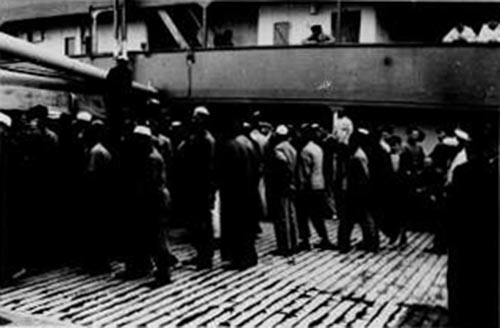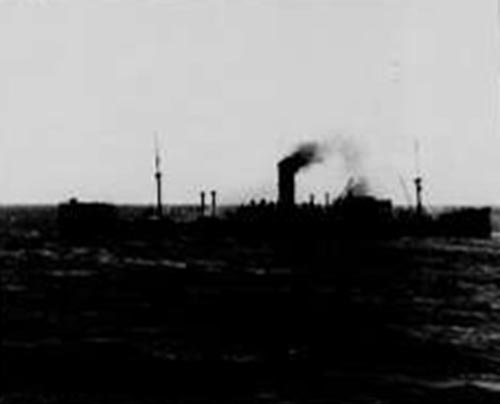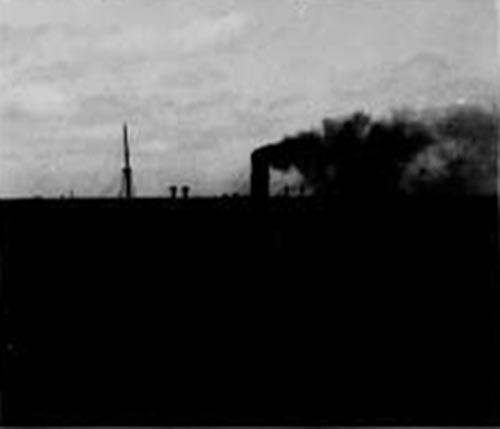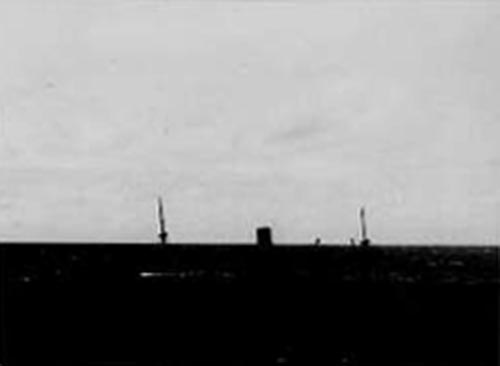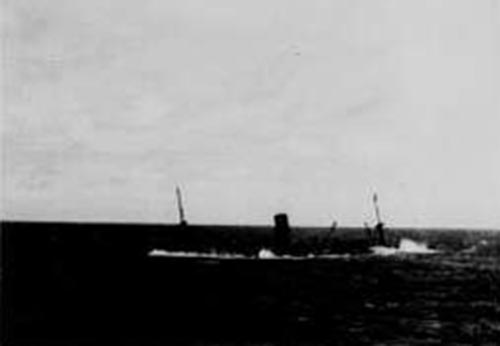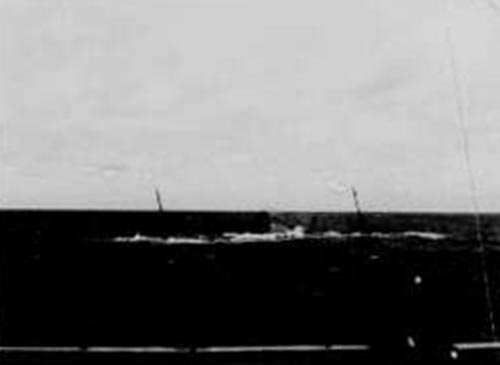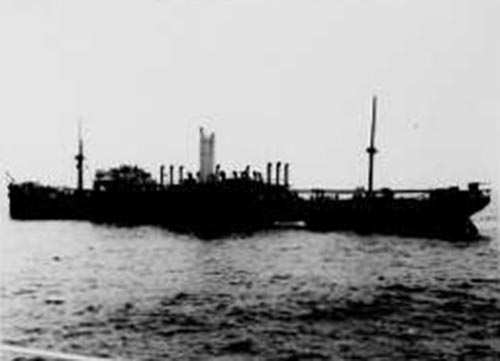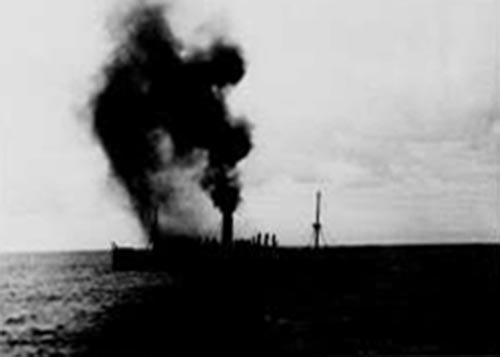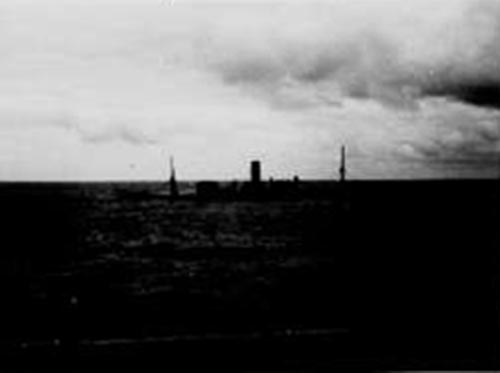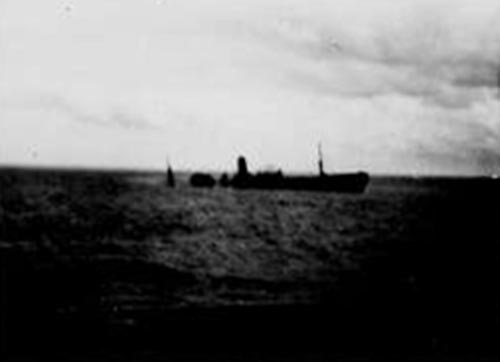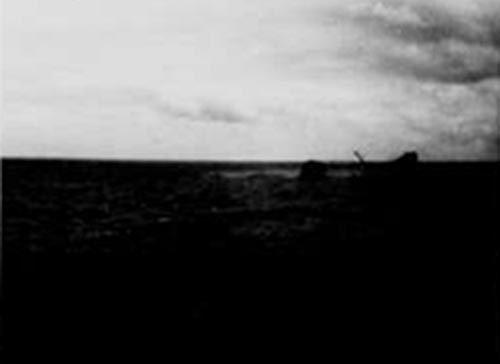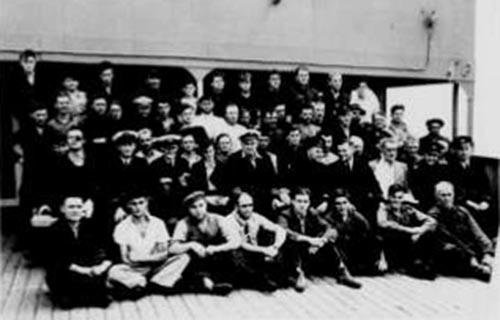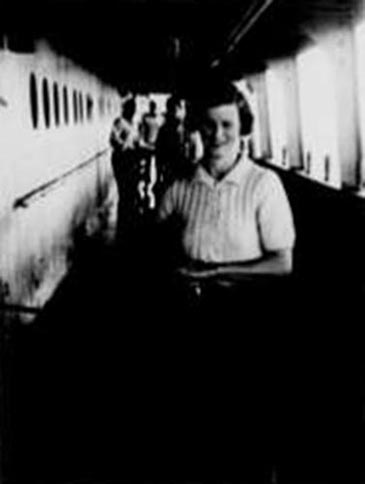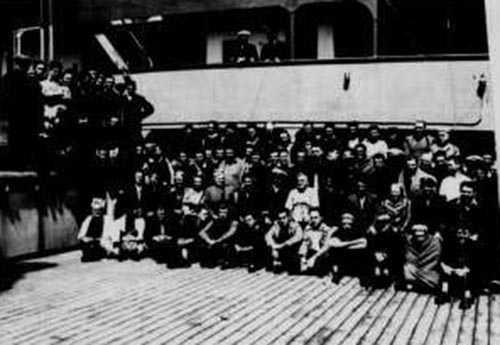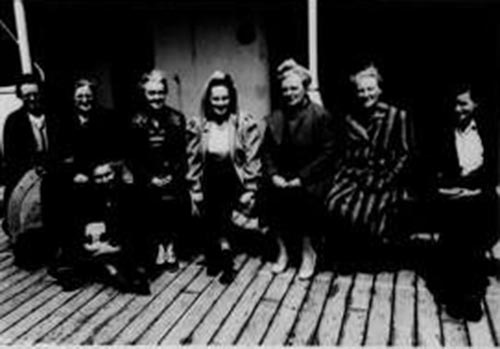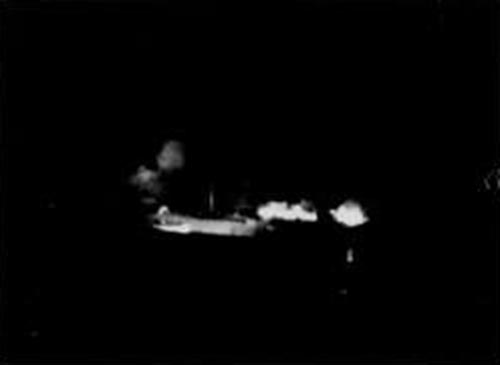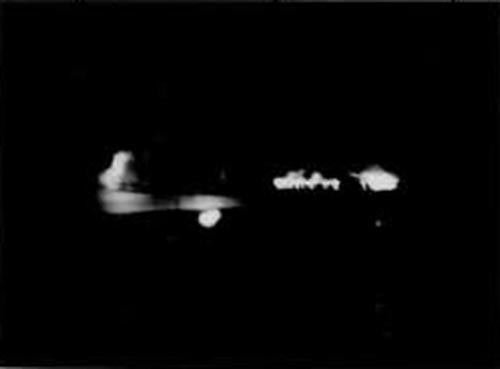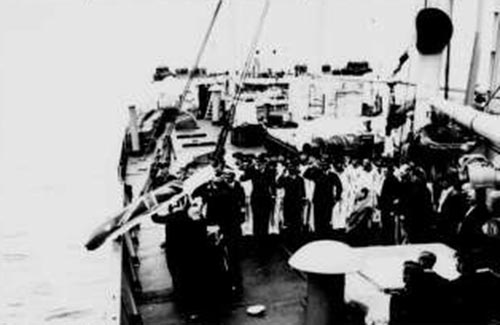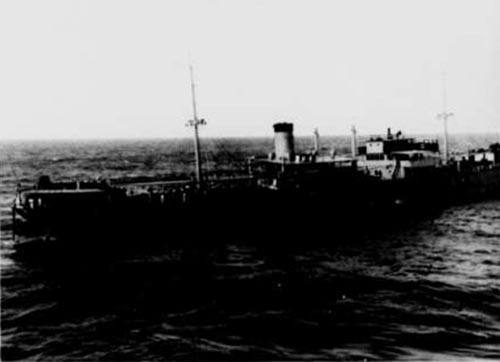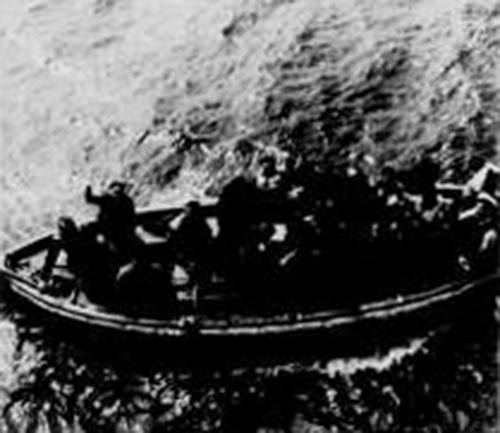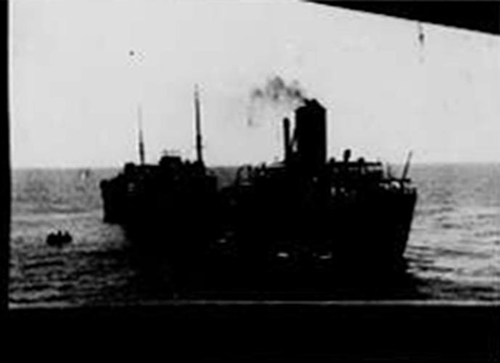| |
- 115 - |
|
| |
|
|
|
|
|
| |
|
|
|
|
|
| |
|
|
|
|
|
| |
|
continued |
|
|
|
| |
|
19.09.40 |
No other ships were seen in Bunbury. For about 3 weeks he had heard that a German raider operated in the Tasman Sea. He knew nothing of auxiliary cruisers in the Indian Ocean. Telegrams were hardly ever sent, because the general instruction was to maintain radio silence. In Bunbury, a very small harbor, there was only his ship. |
|
| |
|
|
So much for the statements made by Captain Hansen at the first interrogation |
|
| |
|
|
On 17 September interrogated for the second time, Hansen admitted that he had not told the full truth the previous day. He corrected his information as follows: |
|
| |
|
|
He was given course directions at Bunbury telling him to steer from Bunbury course to 30°10'S and 50°E, from there true west to 34th or 35th longitude, then a few miles due North and direct course to Port Elizabeth. As ordered, he destroyed these course instructions and the "Bill of Lading" immediately after being stopped. |
|
| |
|
|
In Bunbury he lay with three other ships, namely 2 Yugoslavians and 1 coastal steamer. The departure date and destination of the voyage of these ships were unknown to him. |
|
| |
|
|
He had not been able to determine aircraft reconnaissance himself, but he remembered having heard from his officers that aircraft were observed about 50-100 nm from the coast between 06.00 and 07.00 hours. |
|
| |
|
|
|
|
|
| |
|
|
|
|
|
| |
|
|
The First Officer K. H a l s e and the III. Officer S. M i d t h a s s e l from the Norwegian M.S. "NORDVARD" said: |
|
| |
|
|
Before she went to Australia, the "NORDVARD" lay in Laurenco-Marques (Portuguese East Africa) together with 3 German ships. The Captain's statements about the ship, cargo and port locations were confirmed. There was no telegraphy. Both officers performed telegraphy service part time. The nautical charts with drawn courses in were destroyed by them when they stopped, as this |
|
| |
|
|
|
|
|
| |
|
|
|
|
|
| |
|
|
|
|
|
| |
|
|
|
|
|
| |
|
|
|
|
|
| |
|
|
|
|
|
| |
|
|
|
|
|
| |
|
|
|
|
|
| |
|
|
|
|
|
| |
|
|
|
|
|
 |
 |
 |
 |
 |
 |
| |
- 117 - |
|
| |
|
|
|
|
|
| |
|
|
|
|
|
| |
|
|
|
|
|
| |
|
continued |
|
|
|
| |
|
19.09.40 |
He never thought of a German raider. When the Captain, who was on the lower bridge deck, came on the bridge, he reduced the speed in order to let the other ship pass quickly. He, Midthassel, was unable to discover anything about the sighted ship that would have struck him as suspicious. The stopping shot in front of the bow came as a great surprise to him. Together with the First Officer, he destroyed the nautical charts on which the courses were drawn because the First Officer asked him to do so. Besides, the whole situation was so new to him and so surprising that he was unable to give further thought to the events that were to happen next. |
|
| |
|
|
He did not enter the radio station on 16 September. They did not have a code from the British Admiralty on board. |
|
| |
|
|
|
|
| |
|
|
After solving the new GBMS key, the GBMS radio messages that accrued since the key were changed were subsequently deciphered. On August 28th, the day after the bombardment and detachment of the tanker "BRITISH COMMANDER" Natal/Radio announced to all English merchant ships in the western Indian Ocean: |
|
| |
|
|
|
"Enemy raider shot British merchant steamer in 29°37'S and 45°50'E at 02.40 GMT on 27 August. Possible description: 4000 ton ship, dark gray, 1 smokestack, 2 masts, smokestack even with cross trees, forward and aft well decks, sampson masts on the poop, straight forestem, cruiser stern, speed of a coal ship, in the vicinity of the mast no cannon or davits visible. Pay attention to Admiralty Instructions CF and CJ. |
|
| |
|
|
|
S.N.O. Simonstown" |
|
| |
|
|
|
|
| |
|
|
Where this description came from is unknown, in any case is will be gratefully noted as incorrect. |
|
| |
|
|
|
 |
|
| |
|
|
|
|
|
| |
|
|
|
|
|
| |
|
|
|
|
|
| |
|
|
|
|
|
| |
|
|
|
|
|
| |
|
|
|
|
|
 |
 |
 |
 |
 |
 |
| |
- 118 - |
|
| |
|
|
|
|
|
| |
|
|
|
|
|
| |
|
|
|
|
|
| |
|
|
|
|
|
| |
|
20.09.40 |
29°58'S 76°55'E |
01.00 hours received an RRRR-report with a position 90 nm to the north of ours. The French 10000 ton steamer "COMMISAIRE RAMEL" reported therein that he was being shot at by an unknown ship. I accept that this was Ship 16, that unfortunately is very close and "33" is probably suspected further east. |
|
| |
|
12.00 |
EbyS 4, Sea 3, overcast, Vis. good |
|
| |
|
|
|
|
|
| |
|
|
|
|
|
| |
|
21.09.40 |
31°48'S 78°16'E |
|
|
| |
|
12.00 |
NNE 2, Sea 1-2, overcast, Vis. good |
|
|
| |
|
|
|
|
|
| |
|
|
|
|
|
| |
|
|
|
|
|
| |
|
|
Due to the stay for the capture and outfitting of the prize "NORVARD", it is no longer possible, as planned, to lay the mines in Australia in the new moon period at the end of September. |
|
| |
|
|
Therefore the execution of the mine task must be delayed until the end of October. |
|
| |
|
|
Since I consider the moment of surprise to be indispensable for successfully carrying out a mine task under the enemy coast, I decide not to cross into actual Australian waters before deploying the mines, as a report must always be expected if the British are captured. |
|
| |
|
|
Therefore I intend initially to cruise further on the eastern part of the northern Australian Africa Route between 30° and 35°S, as was evident from the log book of the "NORVARD". |
|
| |
|
|
|
|
|
| |
|
|
|
 |
|
| |
|
|
|
|
|
| |
|
|
|
|
|
| |
|
|
|
|
|
| |
|
|
|
|
|
| |
|
|
|
|
|
| |
|
|
|
|
|
| |
|
|
|
|
|
| |
|
|
|
|
|
 |
 |
 |
 |
 |
 |
| |
- 119 - |
|
| |
|
|
|
|
|
| |
|
|
|
|
|
| |
|
|
|
|
|
| |
|
|
|
|
|
| |
|
22.09.40 |
31°49'S 81°57'E |
|
|
| |
|
12.00 |
N 3-4, Sea 3, cloudy, Vis. good |
|
|
| |
|
|
|
|
|
| |
|
|
|
|
|
| |
|
|
|
|
|
| |
|
|
Made the following considerations for the mining operation on the Australian coast: |
|
| |
|
|
| |
1) |
The written instructions found and the oral statements of the Captains show that all ships are instructed to sail outside the 200-meter line wherever possible. |
| |
|
|
| |
2) |
Fouling Capes or other navigational objective points is pointless, because in most cases, it is possible to bypass using of greater or lesser detours, beyond 200 meters water depth. |
| |
|
|
| |
3) |
For mine laying comes into consideration: |
| |
|
a) |
On the east coast: |
Brisbane, New Castle, Sydney, the east entrance to the Bass Strait, Bank Strait. |
| |
|
|
|
|
| |
|
b) |
On the south coast |
Hobart (southern tip of Tasmania), west entrance to the Bass Strait (Cape Otway), Spencer Gulf, Albany. |
| |
|
|
|
|
| |
|
c) |
On the west coast: |
Fremantle, Geraldton, Shark Bay. |
| |
|
|
|
|
| |
4) |
It is not possible to foul all places in a row with just one ship, as the first mine hit at that point will trigger defense and patrols accordingly in all other places. |
| |
|
By using mines with clockwork delay (delay of up to 48 hours), a little compensation for this disadvantage is possible . There are |
|
|
| |
|
|
|
|
|
| |
|
|
|
|
|
| |
|
|
|
|
|
| |
|
|
|
|
|
| |
|
|
|
|
|
| |
|
|
|
|
|
| |
|
|
|
|
|
 |
 |
 |
 |
 |
 |
| |
- 122 - |
|
| |
|
|
|
|
|
| |
|
|
|
|
|
| |
|
|
|
|
|
| |
|
|
|
|
| |
|
MOZ 90°E |
[GMT +6] |
|
|
| |
|
======== |
|
|
|
| |
|
23.09.40 |
31°46'S 85°29'E |
) |
|
| |
|
12.00 |
WSW 3, Sea 2, overcast, rain, Vis. good to medium |
) |
|
| |
|
|
) |
|
| |
|
|
|
) |
|
| |
|
|
|
) |
|
| |
|
24.09.40 |
31°00'S 86°26'E |
) |
|
| |
|
12.00 |
NNW 1, Sea 1, cloudy, Vis. good |
) |
|
| |
|
|
) In N-S zigzags on |
|
| |
|
|
|
) approximately 32°S |
|
| |
|
|
|
) back and forth in position. |
|
| |
|
25.09.40 |
33°53'S 86°30'E |
) |
|
| |
|
12.00 |
SE 4, Sea 3-4, cloudy, showers, Vis. good to medium |
) |
|
| |
|
|
) |
|
| |
|
|
|
) |
|
| |
|
|
|
) |
|
| |
|
26.09.40 |
33°00'S 87°40'E |
) |
|
| |
|
12.00 |
E 6, Sea 5-6, overcast, rain, Vis. bad |
) |
|
| |
|
|
) |
|
| |
|
|
|
|
|
| |
|
|
|
|
|
| |
|
|
|
|
|
| |
|
|
The following two informative radio messages may serve to illuminate the recurring difficulties with regard to the crews of the enemy or neutral ships sailing for the enemy: |
|
| |
|
|
|
|
|
| |
|
|
|
|
|
| |
|
|
|
|
|
| |
|
|
|
|
|
| |
|
|
|
|
|
| |
|
|
|
|
|
| |
|
|
|
|
|
| |
|
|
|
|
|
 |
 |
 |
 |
 |
 |
| |
- 123 - |
|
| |
|
|
|
|
|
| |
|
|
|
|
|
| |
|
|
|
|
|
| |
|
continued |
|
|
|
| |
|
26.09.40 |
|
|
|
| |
|
|
|
"Algoa-Bay/Radio keyed to GBMS 6 (South Africa) cde 40 CITY OF EXETER only from SNO Simonstown. |
|
| |
|
|
|
|
|
| |
|
|
|
Understand your crew may refuse sail beyond Capetown unless demand lodged Durban are met. Report in writing to naval control service officer Capetown on arrival. You will be berth in Bay pending investigation. |
|
| |
|
|
|
|
|
| |
|
|
|
From S.N.O. Simonstown" |
|
| |
|
|
|
|
|
| |
|
|
Open Radio Message of the Swedish steamer "PAN GOTHIA" to Singapore/Radio. |
|
| |
|
|
|
|
|
| |
|
|
|
"Swedish consulate Singapore. |
|
| |
|
|
|
|
|
| |
|
|
|
Expect arrive Saturday will authorities give permission shifting . . . (the crew) . . . and is fresh crew available. Need one second cook, one mess boy, one carpenter, five deckhands, three assistant engineers, one turner, four motormen and one motor apprentice please telegraph. |
|
| |
|
|
|
janson master." |
|
| |
|
|
|
|
|
| |
|
|
|
|
|
| |
|
27.09.40 |
30°19'S 89°17'E |
) |
|
| |
|
12.00 |
SW 3, Sea 2-3, cloudy, Vis. good |
) |
|
| |
|
|
) |
|
| |
|
|
|
) Back and forth on north-south zigzags on |
|
| |
|
|
|
) approximately 32°S. |
|
| |
|
|
|
) |
|
| |
|
|
|
) |
|
| |
|
28.09.40 |
30°01'S 90°10'E |
) |
|
| |
|
12.00 |
ENE 3, Sea 2, cloudy, Vis. good |
) |
|
| |
|
|
) |
|
| |
|
|
|
|
|
| |
|
|
|
|
|
| |
|
|
|
|
|
 |
 |
 |
 |
 |
 |
| |
- 127 - |
|
| |
|
|
|
|
|
| |
|
|
|
|
|
| |
|
|
|
|
|
| |
|
|
|
|
|
| |
|
29.09.40 |
30°14'S 90°54'E |
|
|
| |
|
12.00 |
SWbyW 5, Sea 5, rain, overcast, Vis. good to bad |
|
|
| |
|
|
|
|
|
| |
|
|
|
|
|
| |
|
|
Because so far no further vessels have come in sight on this route, I decide to try my luck on the advance to the east coast of Australia. I hope to be successful here on the routes to be crossed from Aden, Colombo, Calcutta and above all the Sunda Strait to Australia possibly with the help of aircraft reconnaissance. |
|
| |
|
|
|
|
|
| |
|
|
|
|
|
| |
|
|
|
 |
|
| |
|
|
|
|
|
| |
|
|
|
|
|
| |
|
30.09.40 |
29°33'S 92°57'E |
) |
|
| |
|
12.00 |
WSW 8, Sea 6-7, overcast, rain, Vis. bad |
) |
|
| |
|
|
) |
|
| |
|
|
|
) No particular events. |
|
| |
|
|
|
) |
|
| |
|
01.10.40 |
26°59'S 95°44'E |
) |
|
| |
|
|
W 5, Sea 4-5, cloudy, rain, Vis. good to bad |
) |
|
| |
|
|
) |
|
| |
|
|
|
|
|
| |
|
|
|
|
|
| |
|
|
|
|
|
| |
|
|
|
|
|
| |
|
|
|
|
|
| |
|
|
|
|
|
| |
|
|
|
|
|
| |
|
|
|
|
|
| |
|
|
|
|
|
| |
|
|
|
|
|
 |
 |
 |
 |
 |
 |
| |
- 128 - |
|
| |
|
|
|
|
|
| |
|
|
|
|
|
| |
|
|
|
|
|
| |
|
|
|
|
|
| |
|
02.10.40 |
24°29'S 98°27'E |
) |
|
| |
|
12.00 |
SSE 2, Sea 1-2, cloudy, Vis. good |
) |
|
| |
|
|
) |
|
| |
|
|
|
) |
|
| |
|
|
|
No particular events. |
|
| |
|
MOZ |
|
) |
|
| |
|
105°E |
[GMT +7] |
) |
|
| |
|
===== |
|
) |
|
| |
|
|
|
) |
|
| |
|
03.10.40 |
22°09'S 101°08'E |
) |
|
| |
|
12.00 |
SEbyS 2, Sea 1, clear, Vis. good |
) |
|
| |
|
|
) |
|
| |
|
|
|
|
|
| |
|
|
|
|
|
| |
|
04.10.40 |
20°05'S 103°09'E |
) |
|
| |
|
12.00 |
SEbyE 4, Sea 3, cloudy, Vis. good |
) |
|
| |
|
|
) Setting out and launching the aircraft is still not possible. |
|
| |
|
|
|
) |
|
| |
|
05.10.40 |
17°39'S 105°46'E |
) |
|
| |
|
12.00 |
E 2-3, Sea 2, clear, Vis. good |
) |
|
| |
|
|
|
|
|
| |
|
|
|
|
|
| |
|
06.10.40 |
15°16'S 108°00'E |
The seas appear calmer. The aircraft was launched. Even after maneuvering to make a duck pond for the aircraft, the flight officer reports that take-off is only possible with full commitment. The aircraft was recovered, because at the moment a reconnaissance is arguably desirable but not necessary. |
|
| |
|
12.00 |
ESE 3-4, Sea 3, clear, Vis. good |
|
| |
|
|
|
 |
|
| |
|
|
|
|
|
| |
|
|
|
|
|
| |
|
|
|
|
|
 |
 |
 |
 |
 |
 |
| |
- 129 - |
|
| |
|
|
|
|
|
| |
|
|
|
|
|
| |
|
|
|
|
|
| |
|
|
|
|
|
| |
|
07.10.40 |
15°06'S 107°47'E |
12 strich [138°] to port the mast of a steamer are in sight. Lays athwart. Approximate bearing 290°T. |
|
| |
|
07.10 |
SEbyE 4-5, Sea 4, cloudy, Vis. good |
|
| |
|
|
|
|
|
| |
|
07.22 |
|
Went to full speed and took the steamer directly ahead. To the right of the two masts the smokestack comes in sight. Apparently it is a tanker. |
|
| |
|
|
|
|
|
| |
|
07.25 |
|
Came to an accompanying and unsuspicious course Lombok Strait - Capetown and ran with changing speed, so that the bearing was steady. |
|
| |
|
07.36 |
|
Bearing 295°T 20600 meters. |
|
| |
|
|
|
The steamer steers approximately 160° (Sunda Strait - South coast of Australia). |
|
| |
|
|
|
|
|
| |
|
07.46 |
|
300°T 17600 meters. |
|
| |
|
|
|
After and bridge superstructure gray, bridge brown, smokestack black. |
|
| |
|
|
|
|
|
| |
|
07.50 |
|
Crew to Action Stations. |
|
| |
|
|
|
|
|
| |
|
08.16 |
|
308°T 8500 meters. |
|
| |
|
|
|
Tanker with black hull, gray masts and booms. No neutrality markings, no cannon. |
|
| |
|
|
|
Apparently Dutch or Norwegian, runs 9 knots by plotting, proceeded in such a way that the bearing shifted further astern, to prevent an escape maneuver. |
|
| |
|
|
|
|
|
| |
|
08.25 |
|
On passing through the masts his course was 160°. |
|
| |
|
|
|
|
|
| |
|
|
|
|
|
| |
|
|
|
|
|
| |
|
|
|
|
|
| |
|
|
|
|
|
 |
 |
 |
 |
 |
 |
| |
- 132 - |
|
| |
|
|
|
|
|
| |
|
|
|
|
|
| |
|
|
|
|
|
| |
|
continued |
|
|
|
| |
|
07.10.40 |
|
|
|
| |
|
09.07 |
|
Semaphore message from Examination Officer: |
|
| |
|
|
|
"Norwegian tanker "STORSTAD" from Borneo to Melbourne, 8998 GRT, 36 man crew, 10 knots, 12000 tons diesel and 500 tons bunker oil." |
|
| |
|
|
|
|
|
| |
|
09.12 |
|
Questioned the Examination Officer reports that there are provisions for 3 weeks on board. |
|
| |
|
|
|
|
|
| |
|
09.14 |
|
Orders to Examination Officer: |
|
| |
|
|
|
"Capture the ship, plan to use it as a supply ship." |
|
| |
|
|
|
|
|
| |
|
|
|
From further semaphore messages: |
|
| |
|
|
|
The ship drives in charter of Standard Oil, New York, has cargo from English company to Australian company on board, 50 tons of drinking water and an evaporator for boiler feed water on board. From the ship a steamer was sighted also in the Sunda Strait an English steamer, 3 small warships and 1 aircraft. The tanker was stopped in the Sunda Strait by a Dutch auxiliary cruiser, Officer checked only the Papers. Diesel oil specific gravity is 0.91, flame point 84°C, |
|
| |
|
|
|
|
|
| |
|
|
|
|
|
| |
|
|
I decide, to run out of the Sunda-Route with the tanker and then first fill my bunkers again. |
|
| |
|
|
|
|
|
| |
|
|
|
|
|
| |
|
|
|
The Captain and 2 Officers were brought on board, the rest of the crew remained aboard for now |
|
| |
|
|
|
|
|
| |
|
|
|
|
|
| |
|
|
|
|
|
| |
|
|
|
|
|
| |
|
|
|
|
|
| |
|
|
|
|
|
| |
|
|
|
|
|
 |
 |
 |
 |
 |
 |
| |
- 134 - |
|
| |
|
|
|
|
|
| |
|
|
|
|
|
| |
|
|
|
|
|
| |
|
|
|
|
|
| |
|
08.10.40 |
15°02'S 108°22'E |
|
|
| |
|
09.00 |
SEbyE 3-4, Sea 3, cloudy, Vis. good |
Fueling finished. |
|
| |
|
|
|
|
|
| |
|
|
|
|
|
| |
|
|
Ship 33 took over 1200 tons of diesel oil and so again the full bunker inventory of departure. |
|
| |
|
|
My measure of supplying fuel to the prize "NORVARD" in the hope of being able to supply later, which initially appeared questionable, is now proving correct. |
|
| |
|
|
During the night the ships steamed another 90 nm to the east to remain undisturbed. |
|
| |
|
|
According to the cargo papers the tanker was destined for "Melbourne or other Australian ports". |
|
| |
|
|
The Captain had not received any particular rules of conduct or course instructions. |
|
| |
|
|
|
|
|
| |
|
|
|
|
|
| |
|
|
The Captain, Egil W i l h e l m s e n, and the 3rd Officer, Aage H a n s e n, from the Norwegian Motor ship "STORSTAD" said the following when questioned by the Prisoner Officer, |
|
| |
|
|
|
|
|
| |
|
|
The tanker ship "STORSTAD" is 8998 GRT, belonged to the Shipping Firm A.F. Klaveness & Co. in Oslo and was on the way from the harbor Miri and Sarawak (British Borneo) for the Australian harbor Melbourne, Adelaide and Port Pirie. The cargo consisted of 12481 tons of diesel oil. The ship was in the Charter of the "Standard Oil Company" New York. In the last two years the ship had driven in East Asiatic waters and a made a trip to the U.S.A. On 30 September it left Miri and was expected in Melbourne about on 20 October. |
|
| |
|
|
In the Sunda Strait a total of 6 ships were met. Three small warships were seen, no details were given concerning the type and size. Two had stood under land, the third cruised in the Strait. At the east |
|
| |
|
|
|
|
|
| |
|
|
|
|
|
| |
|
|
|
|
|
| |
|
|
|
|
|
| |
|
|
|
|
|
| |
|
|
|
|
|
 |
 |
 |
 |
 |
 |
| |
- 135 - |
|
| |
|
|
|
|
|
| |
|
|
|
|
|
| |
|
|
|
|
|
| |
|
|
|
|
|
| |
|
|
side of the Strait they were stopped by a Dutch auxiliary cruiser (a small ship with auxiliary armament), the examination lasted about only 10 minutes. A Control Officer viewed the ship's papers from a boat which came alongside. After reviewing them, they were allowed to continue the journey. As a result, they only lost half an hour. A steamer could not be identified exactly, as it was already dark; a Polish steamer was suspected. An English passenger steamer was seen on a westerly course off the Sunda Strait. Additionally, they were circled in the Strait by an aircraft, a monoplane with floats, gray paint and with red triangles on the fuselage and wings. |
|
| |
|
|
He had not heard about German auxiliary cruisers in the Indian Ocean. Some time ago there was talk of a German raider in the Tasman Sea. |
|
| |
|
|
Before the trip, he received various papers and regulations, but he cannot remember exactly which one he received last. There had always been a great many regulations, and he had not studied them in detail on due to their abundance. The main instructions would always have come on board in Singapore, also in the Customs House and at the Console laid out the instructions, and each Captain could have taken them from the stack. Here he also received the wavelength information from the English stations for GBMS radio messages and a transcript from the Admiralty about the interference of radio communications by German auxiliary cruisers. He gave these instructions to the radio operator. They didn't have a key and didn't receive any encrypted telegrams. |
|
| |
|
|
There were no warships in Hong Kong. Aircraft (land-based) were seen about 100 nm from the coast. Running lights were illuminated during the voyage except for the rear steamer light. At the time of the stopping he was in the bathroom and from the 3rd Officer who was on watch, only got the report after the first shot was fired. No papers were destroyed. |
|
| |
|
|
|
|
| |
|
|
The 3rd Officer and the Radio Officer said the following on questioning: |
|
| |
|
|
|
|
|
| |
|
|
|
|
|
| |
|
|
|
|
|
| |
|
|
|
|
|
| |
|
|
|
|
|
| |
|
|
|
|
|
| |
|
|
|
|
|
| |
|
|
|
|
|
| |
|
|
|
|
|
| |
|
|
|
|
|
| |
|
|
|
|
|
 |
 |
 |
 |
 |
 |
| |
- 136 - |
|
| |
|
|
|
|
|
| |
|
|
|
|
|
| |
|
|
|
|
|
| |
|
continued |
|
|
|
| |
|
08.10.40 |
|
|
|
| |
|
|
The ship had not been in Australia during the last two years. According to the written instructions that he received from the Captain, it was forbidden to transmit radio messages. Accordingly, there were no radio transmissions during the entire journey. He continued to ignore the GBMS wavelength setup and the Admiralty's instructions because they had no codes on board. Also they had not received an RRR- or QQQ-report so far, also the meaning of these groups was not known to him. |
|
| |
|
|
Two years ago, a new shortwave transmitter and receiver were installed in the radio room. |
|
| |
|
|
On the morning of the capture, he took over the watch at eight o'clock and immediately shot the sun. Then went into the chart room to calculate the altitude of the sun. Therefore he attached less importance to the lookout. When we came out around 08.30 hours he saw us and took us for a Wilhelmsen steamer. We didn't seem suspicious to him in any way, he just wondered about our course. Immediately afterwards the first warning shot was fired he immediately went to the engine telegraph and put it on "stop", then he ran to the Captain and reported. In the meantime the second shot had been fired. In the excitement he didn't see anything of the muzzle flash and he couldn't tell later where the gun could be. |
|
| |
|
|
|
|
|
| |
|
|
|
|
|
| |
|
|
|
|
|
| |
|
|
Since the ship appears particularly inconspicuous as a tanker, I considered using it as an auxiliary mine ship for the mining tasks I have planned. |
|
| |
|
|
The subsequent inspection on board shows that in the aft superstructure deck, in which there are compartments and a passageway on both sides around the engine ducts, around 100 mines can be accommodated completely inconspicuously and camouflaged after all the equipment has been ripped out. |
|
| |
|
|
I therefore order that the captured Norwegian tanker |
|
| |
|
|
|
|
|
| |
|
|
|
|
|
| |
|
|
|
|
|
| |
|
|
|
|
|
| |
|
|
|
|
|
| |
|
|
|
|
|
| |
|
|
|
|
|
| |
|
|
|
|
|
| |
|
|
|
|
|
| |
|
|
|
|
|
 |
 |
 |
 |
 |
 |
| |
- 142 - |
|
| |
|
|
|
|
|
| |
|
|
|
|
|
| |
|
|
|
|
|
| |
|
continued |
|
|
|
| |
|
10.10.40 |
However, some of the mines are still on the outer decks, since the preparation of the rooms in the superstructure has not yet been completed. |
|
| |
|
|
Over night proceeded with "PASSAT" 90 nm on course 150°, because the ships have drifted in the vicinity of the steamer routes again. |
|
| |
|
|
|
|
|
| |
|
|
|
|
|
| |
|
11.10.40 |
15°14'S 109°21'E |
|
|
| |
|
|
SEbyS 3, Sea 2-3, cloudy, Vis. good |
|
|
| |
|
|
|
|
|
| |
|
|
The arrangements on the "PASAT" continue. Unfortunately the welding and torch work consume12 bottles of oxygen. By evening the 110 mines have disappeared from the outer decks. The camouflage is complete. |
|
| |
|
|
"PASSAT" with 110 mines in the aft superstructure. |
 |
|
| |
|
|
|
|
|
| |
|
|
Excellent work was done by the work details, especially the welders and carpenters, day and night. When the last working group leaves "PASSAT" at 18.00 hours, the |
|
| |
|
|
|
|
|
| |
|
|
|
|
|
| |
|
|
|
|
|
 |
 |
 |
 |
 |
 |
| |
- 144 - |
|
| |
|
|
|
|
|
| |
|
|
|
|
|
| |
|
|
|
|
|
| |
|
continued |
|
|
|
| |
|
12.10.40 |
14°39'S 107°47'E |
|
|
| |
|
12.00 |
SEbyE 4, Sea 3, overcast, Vis. good |
No particular events. |
|
| |
|
|
|
Unfortunately, a hoped-for second steamer did not materialize on this route. |
|
| |
|
|
|
|
|
| |
|
13.10.40 |
14°02'S 107°38'E |
|
|
| |
|
12.00 |
SEbyE 5, Sea 4, cloudy, Vis. good |
|
|
| |
|
|
|
|
|
| |
|
|
|
At 18.30 hours began the advance to the east coast of Australia for completion of the mine task at 13 knots, course 180°. |
|
| |
|
|
|
|
|
| |
|
|
|
|
|
| |
|
14.10.40 |
17°30'S 107°30'E |
) |
|
| |
|
12.00 |
SEbyE 4, Sea 3-4, cloudy, Vis. good |
) |
|
| |
|
|
) |
|
| |
|
|
|
) No particular events. |
|
| |
|
|
|
) |
|
| |
|
15.10.40 |
22°13'S 107°32'E |
) |
|
| |
|
12.00 |
SEbyE 2-3, Sea 2, cloudy, Vis. good |
) |
|
| |
|
|
) |
|
| |
|
|
|
|
|
| |
|
16.10.40 |
27°11'S 108°38'E |
Received the message of appreciation on the award of the Iron Cross 1st Class to the Kommandant and another 50 of the crew the Iron Cross 2nd Class. I will keep 25 of the available Iron Cross 2nd Class until rendezvous with "PASSAT" in order to be able to award every man of the "PASSAT" crew after completing the task. |
|
| |
|
12.00 |
SbyW 3, Sea 2, cloudy, Vis. good |
|
| |
|
|
|
 |
|
| |
|
|
|
|
|
| |
|
|
|
|
|
| |
|
|
|
|
|
 |
 |
 |
 |
 |
 |
| |
- 145 - |
|
| |
|
|
|
|
|
| |
|
|
|
|
|
| |
|
|
|
|
|
| |
|
|
|
|
|
| |
|
17.10.40 |
32°04'S 109°54'E |
On the trip so far the ship has covered 21600 nm = 1 time around the world in 124 days. In the evening each man had a glass of rum. (Motto: Once around!) |
|
| |
|
12.00 |
SWbyS 2-3, Sea 2, overcast, Vis. good |
|
| |
|
|
|
|
|
| |
|
18.10.40 |
36°51'S 111°11'E |
)  |
|
| |
|
12.00 |
WNW 2, Sea 1-2, overcast, Vis. good |
) |
|
| |
|
|
) |
|
| |
|
|
|
) |
|
| |
|
|
|
) |
|
| |
|
MOZ 120° E |
[GMT +8] |
) |
|
| |
|
========= |
|
) |
|
| |
|
19.10.40 |
39°19'S 116°57'E |
) |
|
| |
|
12.00 |
WNW 3-4, Sea 3, overcast, Vis. good |
) |
|
| |
|
|
) No particular events. |
|
| |
|
|
|
) |
|
| |
|
|
|
) |
|
| |
|
20.10.40 |
41°31'S 123°25'E |
) |
|
| |
|
12.00 |
NbyW 4, Sea 3, overcast, Vis. medium |
) |
|
| |
|
|
|
|
|
| |
|
|
|
|
|
| |
|
21.10.40 |
43°22'S 130°16'E |
|
|
| |
|
12.00 |
SWbyW 9-10, Sea 7, Vis. bad |
|
|
| |
|
|
|
The expected heavy weather in this sea area is met. NW-storm. Over noon the crossing the front, wind jumped 90° to SW, in squalls strength 10, heavy stern sea. |
|
| |
|
|
|
|
|
| |
|
|
|
|
|
| |
|
|
|
|
|
| |
|
|
|
|
|
| |
|
|
|
|
|
| |
|
|
|
|
|
 |
 |
 |
 |
 |
 |
| |
- 146 - |
|
| |
|
|
|
|
|
| |
|
|
|
|
|
| |
|
|
|
|
|
| |
|
continued |
|
|
|
| |
|
21.10.40 |
I hope that "PASSAT", which is suspected to be on the same longitude but closer to the Australian coast, will have less high seas. His deck cargo of mines had to be lashed seaworthy without mine rails. |
|
| |
|
|
Yesterday evening QQQ message from an Australian 2000-ton steamer in the east entrance of Bass Strait. Because "Ship 45" and "Ship 36" are still in the vicinity of the U-boat base, apparently a false report. Significant nervousness when repeating, serious keying errors, transmission of code groups without encryption, etc. Repeat of the QQQ-report by Melbourne, Adelaide and Sydney; last station gave Auto-alarm for all steamers. Steamer reports later, suspicious vessel passed out of sight. |
|
| |
|
|
Of course, eight days before my planned mine operation with two ships, I very much regret this madness, which is pleasant in itself, and I hope that the false report will be recognized as such and that the excitement will have subsided by 28 October, without any significant effects on surveillance and patrol activity. |
|
| |
|
|
|
|
|
| |
|
|
|
|
|
| |
|
|
|
 |
|
| |
|
|
|
|
|
| |
|
|
|
|
|
| |
|
|
|
|
|
| |
|
|
|
|
|
| |
|
|
|
|
|
| |
|
|
|
|
|
| |
|
|
|
|
|
| |
|
|
|
|
|
| |
|
|
|
|
|
| |
|
|
|
|
|
| |
|
|
|
|
|
| |
|
|
|
|
|
| |
|
|
|
|
|
| |
|
|
|
|
|
| |
|
|
|
|
|
| |
|
|
|
|
|
| |
|
|
|
|
|
 |
 |
 |
 |
 |
 |
| |
- 147 - |
|
| |
|
|
|
|
|
| |
|
|
|
|
|
| |
|
|
|
|
|
| |
|
|
|
|
|
| |
|
22.10.40 |
44°42'S 137°22'E |
) |
|
| |
|
12.00 |
NWbyW 6, Sea 5, cloudy, Vis. good |
) |
|
| |
|
|
) |
|
| |
|
|
|
) |
|
| |
|
|
|
) |
|
| |
|
MOZ 135° E |
[GMT +9] |
) |
|
| |
|
========= |
|
) |
|
| |
|
23.10.40 |
45°30'S 144°41'E |
) |
|
| |
|
12.00 |
WbyN 7, Sea 6-7, showers, squalls, Vis. good to bad |
) |
|
| |
|
|
) |
|
| |
|
|
|
) |
|
| |
|
|
|
) |
|
| |
|
24.10.40 |
43°51'S 151°38'E |
) |
|
| |
|
12.00 |
SW 6, Sea 6, clear, Vis. good |
) |
|
| |
|
|
|
) |
|
| |
|
|
|
) |
|
| |
|
MOZ 150° E |
[GMT +10] |
) |
|
| |
|
========= |
|
) |
|
| |
|
25.10.40 |
41°51'S 154°52'E |
) |
|
| |
|
|
NW 4, Sea 3, cloudy, Vis. good |
) |
|
| |
|
|
) |
|
| |
|
|
|
) |
|
| |
|
|
|
) |
|
| |
|
26.10.40 |
39°04'S 156°20'E |
) |
|
| |
|
12.00 |
NbyW 3, Sea 2, cloudy, Vis. good |
) |
|
| |
|
|
) |
|
| |
|
|
|
) |
|
| |
|
|
|
) |
|
| |
|
27.10.40 |
35°16'S 157°32'E |
) |
|
| |
|
12.00 |
NWbyN 6-7, Sea 5-6, overcast, Vis. good |
) |
|
| |
|
|
) |
|
| |
|
|
|
|
|
| |
|
|
|
|
|
 |
 |
 |
 |
 |
 |
| |
- 148 - |
|
| |
|
|
|
|
|
| |
|
|
|
|
|
| |
|
|
|
|
|
| |
|
|
|
|
|
| |
|
28.10.40 |
32°48'S 153°31'E |
|
|
| |
|
12.00 |
S 4, overcast, Vis. good |
|
|
| |
|
|
|
|
|
| |
|
|
|
|
|
| |
|
|
The mine fouling on the Australian coast is to take effect suddenly in as many places as possible at the same time in 100-mine groups, using the two mine-laying vessels and the clockwork delay. Therefore, the following timing is provided for throwing: |
|
| |
|
|
|
|
|
| |
|
|
| |
"PINGUIN" |
"PASSAT" |
| 28 October |
Sydney - Newcastle |
- / / - |
| |
(48-hour delay) |
|
| |
|
|
| 29 October |
- / / - |
Bank Strait |
| |
|
(48-hour delay) |
| |
|
|
| 30 October |
- / / - |
East entrance to the Bass Strait |
| |
|
(48-hour delay) |
| |
|
|
| 31 October |
Entrance to Hobart |
West entrance Bass Strait |
 |
 |
 |
|
|
| |
|
|
|
|
|
| |
|
|
I also hope that this regulation will prevent the patrol vessels at the individual places from being alerted prematurely by the effects of mines at other locations. |
|
| |
|
|
The coast north of Sydney is approached on the steamer track with an unsuspicious southwesterly course. |
|
| |
|
|
I do not expect regular sea reconnaissance by air forces here after a war year in which nothing of essential importance has occurred. However, with the brisk aircraft activity on the coast during the day, as is detected in the radio picture, an encounter with aircraft can happen at any time. The upper deck must therefore be vacated in time, except for distributed soldiers in civilian clothes. |
|
| |
|
|
|
|
|
| |
|
|
|
|
|
| |
|
|
|
|
|
| |
|
|
|
|
|
| |
|
|
|
|
|
| |
|
|
|
|
|
 |
 |
 |
 |
 |
 |
| |
- 149 - |
|
| |
|
|
|
|
|
| |
|
|
|
|
|
| |
|
|
|
|
|
| |
|
continued |
|
|
|
| |
|
28.10.40 |
I intend closing the coast and deploying mines as early as possible after the beginning of darkness, to have the greater part of the dark night available to run off, so that even an early aerial reconnaissance flight would find the ship far out at sea on an unsuspicious course. |
|
| |
|
|
|
|
|
| |
|
17.45 |
|
Set Action Stations. |
|
| |
|
|
|
In accordance with the evening navigation fix came to the course line for the first deployment segment and then to course 244°, speed 15 knots. |
|
| |
|
|
|
|
|
| |
|
19.01 |
SSE 2-3, SSE Swell, very dark unclear night |
After dark, 30° to starboard towards Newcastle, a glow sweeping left and right across the horizon comes into view. Initially it was taken as an airfield beacon, however turned out to be a searchlight, regularly searching back and forth to sea. |
|
| |
|
|
|
|
|
| |
|
19.33 |
|
The glow of Port Stephens beacon comes in sight 65° to starboard. |
|
| |
|
|
|
|
|
| |
|
19.40 |
|
In the direction of Sydney a slowly sweeping searchlight comes in sight. Illuminated for approximately 10 minutes. |
|
| |
|
|
|
|
|
| |
|
19.52 |
|
In the direction of Newcastle the glow of 3 searchlights is distinguished, in between the glow of the beacons of Newcastle. Cross bearings from Newcastle and Port Stephens could not be taken because the beacons are still below the horizon. The beacons burn as in peacetime. |
|
| |
|
|
|
Despite the Sea State and Swell the port mine port was opened and the deployment platform was extended. The ingress of water is insignificant, as the ship only rolls and the stern is not much affected. |
|
| |
|
|
|
|
|
| |
|
|
|
|
|
| |
|
|
|
|
|
| |
|
|
|
|
|
| |
|
|
|
|
|
| |
|
|
|
|
|
 |
 |
 |
 |
 |
 |
| |
- 153 - |
|
| |
|
|
|
|
|
| |
|
|
|
|
|
| |
|
|
|
|
|
| |
|
continued |
|
|
|
| |
|
29.10.40 |
Ran to the south at 15 knots to finish Mine Task II off Hobart. |
|
| |
|
|
Because heavy weather is to be expected with mine deployment off the south cost of Tasmania, after yesterday's first experiences with the water penetrating through the mine port, appropriate precautions will be taken. The elbows of the overflow pipes of the aft ammunition chambers in the shaft tunnel are opened, the aft peak emptied and its manhole covers opened and the ship is given a fore trim, so that the mine port has more freeboard. |
|
| |
|
|
Because up to 24.00 hours nothing is heard from "PASSAT", I accept that he has carried out Task I today, fouling the Bank Strait, as planned. |
|
| |
|
|
|
|
|
| |
|
30.10.40 |
40°20'S 151°58'E |
No particular events. |
|
| |
|
12.00 |
SbyW 3, Sea 2, cloudy, Vis. good |
|
|
| |
|
|
Even today, "PASSAT" was not heard from. Therefore Task II, fouling of the east entrance of the Bass Strait, was carried out as planned. |
|
| |
|
|
|
 |
|
| |
|
31.10.40 |
44°19'S 147°59'E |
|
|
| |
|
12.00 |
NE 5-6, Sea 5, misty, rain, Vis. bad |
|
|
| |
|
|
|
|
| |
|
|
With the bad weather, I decide to head for the uninhabited rock Pedra Blanca early in the afternoon, since aerial reconnaissance is not to be expected. |
|
| |
|
|
I very much hope that the unsightly weather will last until the mine-deployment. However, the weather forecaster promises passage of the front with clear visibility. |
|
| |
|
|
|
|
|
| |
|
|
|
|
|
| |
|
|
|
|
|
| |
|
|
|
|
|
| |
|
|
|
|
|
| |
|
|
|
|
|
| |
|
|
|
|
|
| |
|
|
|
|
|
| |
|
|
|
|
|
| |
|
|
|
|
|
 |
 |
 |
 |
 |
 |
| |
- 154 - |
|
| |
|
|
|
|
|
| |
|
|
|
|
|
| |
|
|
|
|
|
| |
|
continued |
|
|
|
| |
|
31.10.40 |
|
|
|
| |
|
15.44 |
Overcast, foggy, drizzle, Vis. bad |
"Pedra Blanca" and "Eddystone Rock" in sight ahead to starboard. Closed at low speed, in order to advance from this exact position, 15 nm off the entrance to the D'Entrecasteaux Channel, in the evening to complete the mine task. |
|
| |
|
|
|
|
|
| |
|
17.05 |
|
The sky was suddenly clear, the rain has stopped and ahead to starboard the snow-covered peaks of the Tasmanian coast mountains, up to 1000 meters high, come into view. Turned away and ran off unto out of visual range. Before darkness came to 335° again and headed for the two rocks. |
|
| |
|
|
|
|
|
| |
|
19.00 |
|
Manned Combat Stations. |
|
| |
|
|
|
Lighthouse at Cape Bruny comes in sight 40° to starboard. |
|
| |
|
|
|
|
|
| |
|
19.37 |
|
"Pedra Blanca" abeam to starboard 2 1/2 nm. Because in the meantime it has completely cleared and is a starry clear night, the horizon in the west is still sharp enough to see, slowed to 10 knots. |
|
| |
|
|
|
|
|
| |
|
20.00 |
|
Cape Bruny taken directly ahead in 23°T. |
|
| |
|
|
|
|
|
| |
|
20.07 |
|
The shine of a searchlight sweeping back and forth across the horizon comes into view in 9°T. |
|
| |
|
|
|
|
|
| |
|
20.21 |
|
Another searchlight sighted in 24°T, apparently it is a searchlight, that are situated on both sides of the D'Entrecasteaux Channel at the strait behind Bruny Island. |
|
| |
|
|
|
|
|
| |
|
|
|
|
|
| |
|
|
|
|
|
| |
|
|
|
|
|
| |
|
|
|
|
|
| |
|
|
|
|
|
 |
 |
 |
 |
 |
 |
| |
- 157 - |
|
| |
|
|
|
|
|
| |
|
|
|
|
|
| |
|
|
|
|
|
| |
|
continued |
|
|
|
| |
|
01.11.40 |
There are no reports from "PASSAT". So it was able to complete its task III, the western entrance to Bass Street, today without any problems. Unfortunately, towards the morning, heavy weather is coming from the northwest, so eventually we had to abandon our southerly course and turn to the west, and later to a northwesterly course. |
|
| |
|
|
For the first time, the ship has to fight against very high, heavy seas. The camouflage of the 7.5 cm stopping gun on the forecastle is destroyed. |
|
| |
|
|
Haven't heard anything yet from "PASSAT", which certainly had to deal with the bad weather on its way out. |
|
| |
|
|
|
|
|
| |
|
02.11.40 |
44°09'S 144°40'E |
|
|
| |
|
|
Storm SWbyW 8, Sea 7, rain, misty, Vis. bad |
|
|
| |
|
|
|
|
|
| |
|
|
The bad weather continues. We are not making any progress. My intention is to try to lay mines off the Spencer Gulf if everything remains calm until then and the coast is not alarmed by any mining successes. However, if the loss of time due to bad weather increases, the nights with the waxing moon will be too bright for such an operation. |
|
| |
|
|
|
|
|
| |
|
03.11.40 |
43°48.5'S 142°00'E |
|
|
| |
|
02.00 |
WNW 6-7, Sea 5-6, overcast, rain, Vis. unclear |
Report from "PASSAT" that all tasks were completed as planned. Great! |
|
| |
|
|
|
The weather has still not improved. The ship works heavily. |
|
| |
|
|
|
 |
|
| |
|
04.11.40 |
42°45'S 137°08'E |
|
|
| |
|
12.00 |
SW 5-6, Sea 5, cloudy, Vis. good |
|
|
| |
|
|
|
|
|
| |
|
|
|
|
|
| |
|
|
|
|
|
| |
|
|
|
|
|
| |
|
|
|
|
|
| |
|
|
|
|
|
| |
|
|
|
|
|
 |
 |
 |
 |
 |
 |
| |
- 158 - |
|
| |
|
|
|
|
|
| |
|
|
|
|
|
| |
|
|
|
|
|
| |
|
continued |
|
|
|
| |
|
04.11.40 |
Slow weather improvement. Speed can be increased. I will still try to complete the Spencer Gulf task |
|
| |
|
|
|
|
|
| |
|
|
|
 |
|
| |
|
|
|
|
|
| |
|
MOZ 135°E |
[GMT +9] |
|
|
| |
|
========= |
|
|
|
| |
|
05.11.40 |
38°44'S 131°34'E |
|
|
| |
|
12.00 |
NNE 3, Sea 2, cloudy, Vis. good |
|
|
| |
|
|
|
|
|
| |
|
|
Good weather. Tried to made to make up some of the lost time by traveling at full speed, particularly since a new fuel supply from "PASSAT" is likely. I hope to be able to deploy the mines tomorrow evening, despite the quarter-moon. |
|
| |
|
|
Shortly before dark, two masts, apparently from a tanker, come into sight under the horizon, heading for Melbourne. As we approached to make further observations, he turned away. He is "playing along". As darkness is now rapidly approaching, it is doubtful the steamer will be found if she changes course again, and there is still a possibility that she will radio when approached, having already turned away when in sight, I decide not to try again to find the steamer in the interests of tomorrow's mine-laying mission. This decision, which I did not make with great joy, is made easier by the possibility that the steamer could run into one of the "PASSAT" mines in the entrance to Bass Strait. |
|
| |
|
|
|
 |
|
| |
|
|
|
|
|
| |
|
|
|
|
|
| |
|
|
|
|
|
| |
|
|
|
|
|
| |
|
|
|
|
|
| |
|
|
|
|
|
| |
|
|
|
|
|
| |
|
|
|
|
|
| |
|
|
|
|
|
| |
|
|
|
|
|
 |
 |
 |
 |
 |
 |
| |
- 159 - |
|
| |
|
|
|
|
|
| |
|
|
|
|
|
| |
|
|
|
|
|
| |
|
|
|
|
|
| |
|
06.11.40 |
35°20'S 133°29'E |
|
|
| |
|
14.45 |
Changing wind 1-3, overcast, showers, thunder clouds, rain, Vis. worse |
A steamer came into sight under land in 0°T on the easterly approach course, 3 masts, bridge visible. |
|
| |
|
|
|
|
|
| |
|
15.00 |
|
Because I want to remain unseen immediately before the mine task, turned away to course 180° and ran until out of sight. |
|
| |
|
|
|
|
|
| |
|
15.17 |
|
Steamer out of sight, turned to course 90° and stopped, to begin the advance from here towards evening. |
|
| |
|
|
|
|
|
| |
|
17.00 |
|
Course 88°, 8 knots. |
|
| |
|
|
|
|
|
| |
|
18.00 |
|
15 knots. |
|
| |
|
|
|
|
|
| |
|
21.15 |
|
Glow of "South Neptunes" lighthouse in sight. |
|
| |
|
|
|
|
|
| |
|
21.35 |
|
Glow of "Cape Borda" Lighthouse Kangaroo Island in sight. Completely calm sea, overcast, however bright night from the moon, however low visibility, misty horizon, at the beginning the moon broke through sometimes, then however, the clouds closed up completely. |
|
| |
|
|
|
|
|
| |
|
22.30 |
|
Came to course 104° to the start point of the deployment courses. |
|
| |
|
|
|
|
|
| |
|
22.47 |
|
The front course of "South Neptunes" in sight, came to mine deployment course 134°. |
|
| |
|
|
|
|
|
| |
|
23.03 |
|
The 1st mine went in depth 118 meters. |
|
| |
|
|
|
|
|
| |
|
|
|
|
|
| |
|
|
|
|
|
| |
|
|
|
|
|
 |
 |
 |
 |
 |
 |
| |
- 160 - |
|
| |
|
|
|
|
|
| |
|
|
|
|
|
| |
|
|
|
|
|
| |
|
continued |
|
|
|
| |
|
06.11.42 |
|
|
|
| |
|
23.16 |
|
Section I. ended. |
|
| |
|
|
|
|
|
| |
|
23.20 |
|
Came to new deployment course 162°. No water entry aft. |
|
| |
|
|
|
|
|
| |
|
23.28 |
|
1st mine Section II, depth 125 meters. |
|
| |
|
|
|
After moonset now very low visibility weather, overcast, misty, horizon is barely recognizable, however the beacons are easily recognized. |
|
| |
|
|
|
|
|
| |
|
23.45 |
|
Section II ended. |
|
| |
|
|
|
|
|
| |
|
23.49 |
|
Came to new course 138°. |
|
| |
|
|
|
|
|
| |
|
23.59 |
|
1st mine Section III. Deployment section depth 132 meters. |
|
| |
|
|
|
|
|
| |
|
07.11.40 |
|
|
|
| |
|
00.16 |
|
Section III ended. The deployment platform is retracted, the gate is closed. |
|
| |
|
|
|
|
|
| |
|
|
|
No vessels or searchlights were observed here. Radio traffic from individual patrol vessels was heard and tracked further inside. At around 23.30 hours they ended their radio traffic and wished us "good night". |
|
| |
|
|
|
|
|
| |
|
00.20 |
|
Ran off on course 250° at 15 knots. |
|
| |
|
|
|
|
|
| |
|
05.00 |
|
In the course of the morning aircraft radio traffic was observed repeatedly. |
|
| |
|
|
|
|
|
| |
|
12.00 |
36°39'S 132°31'E |
Ran off at top speed until midday, then headed west at 9 knots on the Melbourne - SW corner of Australia track, on which the tanker was recently encountered. |
|
| |
|
|
WNW 5-6, Sea 4-5, misty, Vis. medium |
|
| |
|
|
|
|
|
| |
|
|
|
|
|
 |
 |
 |
 |
 |
 |
| |
- 162 - |
|
| |
|
|
|
|
|
| |
|
|
|
|
|
| |
|
|
|
|
|
| |
|
continued |
|
|
|
| |
|
08.11.40 |
These ship losses, as can be seen from the time groups of the radio messages in question, obviously caused a great deal of nervousness among the Australian naval authorities. They were communicated in code to all British merchant ships, and a general warning was issued to shipping about endangered areas within a radius of 30 nautical miles around Cape Otway and Promontory Point. |
|
| |
|
|
This endangered area, which is being warned about, does not even come close to encompassing the fouling reported in both locations. |
|
| |
|
|
9 minutes after the general warning against sailing in the area around Promontory Point, the order was issued to close the entire Bass Strait and Port Philippe to all shipping until further notice. Ships destined for Melbourne are to call at the nearest suitable port. |
|
| |
|
|
A hardly hoped-for success of the mine fouling in two places. |
|
| |
|
|
Since it is unlikely to encounter any steamers on the route to Melbourne after these events, course was changed to the great circle Adelaide - Cape Town to continue the transit westward. |
|
| |
|
|
There is a heavy counter swell. |
|
| |
|
|
|
|
|
| |
|
|
|
 |
|
| |
|
|
|
|
|
| |
|
|
|
|
|
| |
|
|
|
|
|
| |
|
|
|
|
|
| |
|
|
|
|
|
| |
|
MOZ 120°E |
[GMT +8] |
|
|
| |
|
======== |
|
|
|
| |
|
09.11.40 |
37°32'S 127°21'E |
|
|
| |
|
|
WbyS 2-3. Sea 2, overcast, misty, Vis. medium |
|
|
| |
|
|
|
|
|
| |
|
|
From the radio news broadcasts of the Australian transmitter |
|
| |
|
|
|
|
|
| |
|
|
|
|
|
| |
|
|
|
|
|
| |
|
|
|
|
|
 |
 |
 |
 |
 |
 |
| |
- 165 - |
|
| |
|
|
|
|
|
| |
|
|
|
|
|
| |
|
|
|
|
|
| |
|
|
|
|
|
| |
|
10.11.40 |
38°17'S 123°39'E |
Continued high swell. |
|
| |
|
12.00 |
W 7-8, Sea 6-7, cloudy, Vis. good |
|
|
| |
|
|
|
|
|
| |
|
|
After leaving the bad weather area I intend to begin the necessary overhaul of the main engines. During this period the ship will have only one operable engine, highest speed 11 knots. |
|
| |
|
|
After meeting with "PASSAT" first fuel oil supply is planned, then operation together - covering a larger sea area - come in question or further mine tasks for "PASSAT". This depends primarily on the condition of "PASSAT's" engines. |
|
| |
|
|
A previously planned transfer of this fuel source to Ship 36 is likely to be canceled due to the modified operational plan of this ship, since instead of the previously planned homeward-bound operation through the Indian Ocean, it will now remain in the South Seas for the time being in order to operate there together with Ship 45. |
|
| |
|
|
|
|
|
| |
|
|
Skl. reports the sinking of the American steamer "CITY OF RAYVILLE" and congratulates Ship 33 on the success. I gather from this that the further, very serious consequences of the ship's mining activities have not yet become known to the Skl., although the closure of Bass Strait and the loss of two steamers have been announced in the Japanese and Manila press. |
|
| |
|
|
|
|
|
| |
|
|
Excerpt of the Australian News of 10 November, 07.00 ZZ: |
|
| |
|
|
The Australian Navy Minister Melbourne announced that naval units were deployed to remove the minefield, as well as aircraft that would simultaneously search for the raider that was probably nearby. Several mines have already been cleared and removed, and barriers have been identified. With these losses, Australia has lost 4 ships in this war, while hundreds of thousands have left and |
|
| |
|
|
|
|
|
| |
|
|
|
|
|
| |
|
|
|
|
|
| |
|
|
|
|
|
| |
|
|
|
|
|
| |
|
|
|
|
|
| |
|
|
|
|
|
| |
|
|
|
|
|
 |
 |
 |
 |
 |
 |
| |
- 167 - |
|
| |
|
|
|
|
|
| |
|
|
|
|
|
| |
|
|
|
|
|
| |
|
continued |
|
|
|
| |
|
12.11.40 |
The Australian Naval Authority announced by radio that on 14 November the Bass Strait can be sailed again. However, all ships have to ask for the approved route in advance in an Australian port. This obligation remains in effect after the 6-day complete closure of the Bass Strait. |
|
| |
|
|
|
|
|
| |
|
|
|
|
|
| |
|
|
|
|
|
| |
|
|
Excerpt of the Japan Press of 12 November, 00.30 ZZ: |
|
| |
|
|
Experts have examined the metal fragments, which were thought to be parts of a mine and found in the lifeboats of the American freighter "CITY OF RAYVILLE". The freighter sank yesterday as a result of an explosion 120 nm from Melbourne. Captain Cronin said the metal parts were not from the ship. Meanwhile, minesweepers have lined up the Bass Strait, where the explosion took place, to search for further mines. The mines tentatively found in Bass Strait are believed to have been laid by a German submarine, as a surface ship would have difficulty escaping searches s in Australian waters. The second officer, Mr. Green, described the explosion and said: "It was a deafening explosion without any warning." Mr. Green said: "The ship sank incredibly quickly forward up to the bridge." "CITY OF RAYVILLE" was the first American ship sunk in the current war. The freighter was lost at one of the farthest points from America touched by American shipping. |
|
| |
|
|
|
|
|
| |
|
|
|
|
|
| |
|
|
|
|
|
| |
|
|
Excerpt of the Australian Midday News of 12 November 1940: |
|
| |
|
|
According to a report from Melbourne, the minesweepers have carried out their search despite the stormy weather, which greatly hampered mine detection, |
|
| |
|
|
|
|
|
| |
|
|
|
|
|
| |
|
|
|
|
|
| |
|
|
|
|
|
| |
|
|
|
|
|
| |
|
|
|
|
|
| |
|
|
|
|
|
| |
|
|
|
|
|
| |
|
|
|
|
|
| |
|
|
|
|
|
 |
 |
 |
 |
 |
 |
| |
- 169 - |
|
| |
|
|
|
|
|
| |
|
|
|
|
|
| |
|
|
|
|
|
| |
|
|
|
|
|
| |
|
MOZ 105°E |
[GMT +7] |
|
|
| |
|
======== |
|
|
|
| |
|
13.11.40 |
36°44'S 108°21'E |
|
|
| |
|
12.00 |
NE 1-2, Sea 1, overcast, clear, Vis. good |
|
|
| |
|
|
|
Began the engine overhaul in the evening. |
|
| |
|
|
|
|
|
| |
|
|
|
|
|
| |
|
|
|
|
|
| |
|
|
The engines have run without an overhaul since the commissioning of the ship in February 1940, since putting to see on 15 June 1940 continuously. |
|
| |
|
|
In addition to removing and cleaning all valves, exhaust lines and mufflers, the pistons must be pulled out of each cylinder and cleaned. In order to limit the time of the second engine is out of service to a minimum, using a spare piston, the piston of a cylinder is pulled in one night and replaced by a piston that has been overhauled, so that the second engine is ready to run again during the day. |
|
| |
|
|
Several work groups were are put together for day and night work. The mechanical personnel were supplemented by aircraft and mine mechanics as well as individual seamanship personnel. The rolling ship must be positioned into the swell while the pistons are being pulled and installed. |
|
| |
|
|
|
|
|
| |
|
|
|
|
|
| |
|
|
Excerpt of the ABC Radio Midday News of 13 November 1940: |
|
| |
|
|
It was announced from Melbourne that in the future a permanent patrol service will be set up along the coast. |
|
| |
|
|
After several mines found by minesweepers were examined, it is now clear that the mines are of German origin. Mine-sweeping is progressing further every day and none of the mines that have yet to be cleared will be of any use to the enemy. |
|
| |
|
|
|
|
|
| |
|
|
Reuters Copyright-Press s of 13 November 1940: |
|
| |
|
|
Melbourne: It is now known for certain, and |
|
| |
|
|
|
|
|
| |
|
|
|
|
|
| |
|
|
|
|
|
| |
|
|
|
|
|
 |
 |
 |
 |
 |
 |
| |
- 170 - |
|
| |
|
|
|
|
|
| |
|
|
|
|
|
| |
|
|
|
|
|
| |
|
continued |
|
|
|
| |
|
13.11.40 |
confirmed by the Minister of the Navy, that a German raider recently laid the mines which caused the loss of a British and an American merchant ship. The raider must still be within a certain radius, and naval and air reconnaissance aircraft are searching diligently for it. |
|
| |
|
|
|
|
|
| |
|
14.11.40 |
33°47'S 104°13'E |
|
|
| |
|
12.00 |
NEbyN 1, Sea 0-1, cloudy, clear, Vis. good |
|
|
| |
|
|
|
Radio Message concerning "Special recognition by Skl. for excellently carried out fouling operation. |
|
| |
|
|
|
|
|
| |
|
|
Excerpt of the ABC Radio Midday News of 14 November 1940: |
|
| |
|
|
As of today, the Bass Strait is free for shipping, after the enemy mines were cleared by mine search formations. The Bass Strait is of particular importance as an access route to the South Australian ports, since Australia, as a port of call of Great Britain, exports its goods to the homeland from here. Equally important is the port of Hobart with its large grain storage facilities. Of course, such important waters were protected from the beginning of the war by a large-scale patrol service by the Navy and Air Force. This protection has been significantly strengthened. Apparently a German raider managed to pass the Strait. Air units are searching for it. |
|
| |
|
|
|
|
|
| |
|
|
|
 |
|
| |
|
|
|
|
|
| |
|
|
|
|
|
| |
|
|
|
|
|
| |
|
|
|
|
|
| |
|
|
|
|
|
| |
|
|
|
|
|
| |
|
|
|
|
|
| |
|
|
|
|
|
| |
|
|
|
|
|
| |
|
|
|
|
|
| |
|
|
|
|
|
| |
|
|
|
|
|
 |
 |
 |
 |
 |
 |
| |
- 172 - |
|
| |
|
|
|
|
|
| |
|
|
|
|
|
| |
|
|
|
|
|
| |
|
continued |
|
|
|
| |
|
15.11.40 |
31°28'S 101°31'E |
|
|
| |
|
12.00 |
SE 1, Sea 0, cloudy, clear, Vis. good |
"PASSAT" Kommandant comes on board to report. |
|
| |
|
|
|
"PASSAT" Kriegstagebuch, deployment sketches and track chart are at hand. |
|
| |
|
|
|
In the afternoon "PINGUIN" lay on a towline at the stern of the tanker. Until night 810 tons of diesel fuel were taken over. |
|
| |
|
|
|
|
|
| |
|
|
|
|
|
| |
|
|
Without the fuel supply from "STORSTAD" for their use and the probability of the new supply possibility from "PASSAT" I would have had to put much more time for the mining operation around the Australian coast at economical speed (9 knots). |
|
| |
|
|
In order to consider the further use of "PASSAT", one first has to determine our own time allocation. |
|
| |
|
|
I'm expect to receive instructions from the Skl. regarding the operation in the Antarctic planned for December/January 1941, at least a partition of the catching areas in case - as we have planned so far - more commerce raiders go to the Antarctic. |
|
| |
|
|
If I don't receive any further instructions, I intend to advance southwards into the Kerguelen area and search the catching areas from east to west. The advance should take place in the first half of December at the latest, as long transits must be carried out economically despite fuel replenishment. |
|
| |
|
|
Until then - about 3 weeks - the engine overhaul is the important thing for "PINGUIN". |
|
| |
|
|
To the extent compatible with this, will also try to wage cruiser war west of Australia at this time (highest speed with one engine with good weather 10.5 knots. There is already heavy marine growth). How can "PASSAT" be used further for warfare? |
|
| |
|
|
|
|
|
| |
|
|
|
|
|
| |
|
|
|
|
|
| |
|
|
|
|
|
| |
|
|
|
|
|
| |
|
|
|
|
|
| |
|
|
|
|
|
| |
|
|
|
|
|
| |
|
|
|
|
|
 |
 |
 |
 |
 |
 |
| |
- 175 - |
|
| |
|
|
|
|
|
| |
|
|
|
|
|
| |
|
|
|
|
|
| |
|
continued |
|
|
|
| |
|
16.11.40 |
|
For communications a Hagenuk device was given on board, with which telephone calls can be made up to a distance of 100 nm after fixed signal letter groups are called on Shortwave. |
|
| |
|
18.00 |
|
"STORSTAD" was released to take up an eastern patrol position, since "PENGUIN" is not maneuverable tonight to inspect the fuel filter. |
|
| |
|
|
|
 |
|
| |
|
|
|
|
|
| |
|
|
|
|
|
| |
|
17.11.40 |
30°54'S 101°22'E |
The engine overhaul is making good progress as planned, and the individual permanent work groups have settled in well. |
|
| |
|
12.00 |
SEbyE 4-5, Sea 3-4, overcast, Vis. good |
|
| |
|
|
|
A square chart has been prepared for the joint operation, which makes it much easier to navigate the two ships. I intend to be at about 30°S moving back and forth on an E-W course, with "STORSTAD" to the north. |
|
| |
|
19.00 |
|
Shortly before darkness smoke cloud in sight abeam to starboard. |
|
| |
|
|
|
Turned towards on course 190° at HF. |
|
| |
|
|
|
Only one engine is ready, the other is currently being prepared to remove a piston; fortunately the cylinder itself has not yet been taken apart, so that the engine can be operable in an hour. |
|
| |
|
19.28 |
|
Came to course 241° - suspected course to follow. |
|
| |
|
|
|
|
|
| |
|
|
|
|
|
| |
|
|
|
|
|
| |
|
|
|
|
|
| |
|
|
|
|
|
| |
|
|
|
|
|
| |
|
|
|
|
|
| |
|
|
|
|
|
| |
|
|
|
|
|
 |
 |
 |
 |
 |
 |
| |
- 177 - |
|
| |
|
|
|
|
|
| |
|
|
|
|
|
| |
|
|
|
|
|
| |
|
continued |
|
|
|
| |
|
18.11.40 |
|
The assumed situation has been found to be correct. |
|
| |
|
|
|
Moved off a bit to have a clear view free of smoke and gun smoke in wind lee. I expect that the alertness of the steamer is bad aft. |
|
| |
|
|
|
|
|
| |
|
00.30 |
|
Came to 14 knots and shortly thereafter 15 knots - full speed. |
|
| |
|
|
|
Came to a pursuit course again, so that ship's bearing is steady. |
|
| |
|
|
|
|
|
| |
|
01.42 |
|
Bearing approximately 255°T, 8 nm away. The overcast was lighter and finally breaks up, the full moon is seen now and then, then I'm in an unfavorable position astern. |
|
| |
|
|
|
The smokestack and masts of the steamer are recognized. |
|
| |
|
|
|
|
|
| |
|
01.58 |
|
1st and 6th cannon, bow gun , radar and searchlight were exposed. |
|
| |
|
|
|
|
|
| |
|
02.21 |
|
Bearing 243°T, 5800 meters. |
|
| |
|
|
|
Large, long ship, estimated at 7000 tons, piston ship with a crew of about 70 men. |
|
| |
|
|
|
|
|
| |
|
02.37 |
|
Bearing 236°T, range 4300 meters. |
|
| |
|
|
|
Steamer suddenly turns away 20°, was now stopped: |
|
| |
|
|
|
|
|
| |
|
02.39 |
|
One shot before the bow. Morse call: |
|
| |
|
|
|
"A - A - A - Stop - A - A - A - Stop -" |
|
| |
|
|
|
|
|
| |
|
02.41 |
|
Shows he finally got it and sends: |
|
| |
|
|
|
|
|
| |
|
|
|
|
|
| |
|
|
|
|
|
| |
|
|
|
|
|
| |
|
|
|
|
|
 |
 |
 |
 |
 |
 |
| |
- 179 - |
|
| |
|
|
|
|
|
| |
|
|
|
|
|
| |
|
|
|
|
|
| |
|
continued |
|
|
|
| |
|
18.11.40 |
|
|
|
| |
|
03.06 |
|
The men leave the gun as the searchlight continues to focus on them. |
|
| |
|
|
|
|
|
| |
|
03.11 |
|
Morse traffic: |
|
| |
|
|
|
"Wait for my Examination Officer". Understood. |
|
| |
|
|
|
Stopped off his bow, so that he can't shoot, and a boat can be launched. |
|
| |
|
|
|
|
|
| |
|
03.19 |
|
Morse traffic: |
|
| |
|
|
|
"My boat is coming now!" |
|
| |
|
|
|
The boat sets off. It has been agreed with the Examination Officer: In case of danger, red star, the steamer will then be torpedoed immediately (we will use a green star). |
|
| |
|
|
|
|
|
| |
|
03.29 |
|
Prize crew goes on board. The situation is still unclear. I believe its possible that the Englander thinks we are an English auxiliary ship and on recognizing the prize crew will open fire. In this case I will immediately torpedo the steamer without regard to my own prize crew, since, according to previous experience, there is still enough time to get into the boats when the torpedo is fired. |
|
| |
|
|
|
|
|
| |
|
03.31 |
|
Morse traffic from Examination Officer: |
|
| |
|
|
|
"From Adelaide for Durban, zinc and wool". |
|
| |
|
|
|
The steamer is under our control. Unfortunately the secret papers are destroyed. The cannon and radio room were occupied. Initially the 15 Europeans of the crew were sent on board. The remaining, unfortunately a very large crew, consist of Indians. I intend, to bring over all provisions and mail found on board in the course of the day, |
|
| |
|
|
|
|
|
| |
|
|
|
|
|
| |
|
|
|
|
|
| |
|
|
|
|
|
 |
 |
 |
 |
 |
 |
| |
- 192 - |
|
| |
|
|
|
|
|
| |
|
|
|
|
|
| |
|
|
|
|
|
| |
|
continued |
|
|
|
| |
|
20.11.40 |
|
|
|
| |
|
05.44 |
|
Came to 12 knots with both engines. |
|
| |
|
|
|
The second engine, is now fully overhauled, turned slowly to break it in. |
|
| |
|
|
|
Came further to course 191°. |
|
| |
|
|
|
|
|
| |
|
06.10 |
|
From the foremast: Smokestack in sight. |
|
| |
|
|
|
|
|
| |
|
06.20 |
|
Masts are distinguished, lie at a great distance from the smokestack, apparently a large steamer, lies transverse. Course 270° (south coast of Australia - Africa) - so again a steamer with cargo. |
|
| |
|
|
|
|
|
| |
|
06.29 |
|
Came to course 260°, a course to run with, to get an indication of enemy speed. |
|
| |
|
|
|
|
|
| |
|
06.32 |
|
Between the bridge and smokestack and behind the smokestack pole masts area seen. Steamer runs at more than 9 knots. |
|
| |
|
|
|
|
|
| |
|
07.00 |
|
Bearing 188°T, 28000 meters. By plotting ran at 12 knots. |
|
| |
|
|
|
|
|
| |
|
07.20 |
|
Bearing 191°T, 24500 meters. Steamer turned away slowly. Tried to proceed smoke-free. |
|
| |
|
|
|
|
|
| |
|
07.25 |
|
Steamer turned away hard 70-80°. |
|
| |
|
|
|
|
|
| |
|
|
The steamer had sighted us and turned away as prescribed. So he would be reached by day after many hours of pursuit, during which he will have the opportunity to send a radio signal for hours. Therefore I'll let him run out of visual range and intend to keep him in sight, always by his clouds of smoke that give him away from 25 to 30 nautical miles away, and to maneuver ahead myself unseen in order to surprise him from ahead in the first dark hours of the night, so that he will not have much time to send radio signals. |
|
| |
|
|
|
|
|
| |
|
|
|
|
|
| |
|
|
|
|
|
 |
 |
 |
 |
 |
 |
| |
- 194 - |
|
| |
|
|
|
|
|
| |
|
|
|
|
|
| |
|
|
|
|
|
| |
|
continued |
|
|
|
| |
|
20.11.40 |
|
to the end, a second bag was thrown in a new approach from aft, which fell on the bridge, with the following contents: |
|
| |
|
|
|
"Stop your engines immediately. |
|
| |
|
|
|
Do not use wireless. |
|
| |
|
|
|
In case of disobedience or any resistance you will be bombed and shelled." |
|
| |
|
|
|
|
|
| |
|
13.50 |
|
The first bomb is thrown in steeply guided flight, which fell into the water about half a ship’s width from the hull at the level of the bridge. |
|
| |
|
|
|
|
|
| |
|
13.51 |
|
Steamer turns away hard. |
|
| |
|
|
|
|
|
| |
|
13.54 |
|
Second bomb thrown, falls armed, about 15 meters ahead of the bow. |
|
| |
|
|
|
|
|
| |
|
13.59 |
|
Steamer smokes. |
|
| |
|
|
|
|
|
| |
|
14.03 |
|
Steamer gave aircraft warning report by Radio Message. |
|
| |
|
|
|
33 picked up the hunt at maximum speed. |
|
| |
|
|
|
|
|
| |
|
14.03 |
|
Steamer gave position, apparently apparently he quickly pulled out an emergency antenna. It is the English steamer "MAIMOA", by Lloyd's Register 8011 GRT, 13-14 knots, cold storage rooms. |
|
| |
|
|
|
|
|
| |
|
14.15 |
|
Bearing 149°T, 21500 meters. |
|
| |
|
|
|
|
|
| |
|
14.19 |
|
Steamer now transmits with his proper transmitter, apparently his system is fully operational again. He sends RRR-report with Position and name. |
|
| |
|
|
|
|
|
| |
|
14.25 |
|
Aircraft flies back and reports: |
|
| |
|
|
|
"Antenna is torn away" |
|
| |
|
|
|
"Steamer does not stop" |
|
| |
|
|
|
"Cannon is not manned" |
|
| |
|
|
|
|
|
| |
|
|
|
|
|
 |
 |
 |
 |
 |
 |
| |
- 195 - |
|
| |
|
|
|
|
|
| |
|
|
|
|
|
| |
|
|
|
|
|
| |
|
continued |
|
|
|
| |
|
20.11.40 |
|
"Anti-aircraft manned" |
|
| |
|
|
|
Afterwards flew off again after the steamer. |
|
| |
|
|
|
|
|
| |
|
14.50 |
|
"STORSTAD" receives order to move off to a square far to the NW. The steamer transmits repeatedly, the aircraft carries out mock attacks on it. The steamer then makes hard rudder maneuvers and lays smoke. |
|
| |
|
|
|
|
|
| |
|
14.57 |
|
The steamer reports he is hunted, steers 150° at 11 knots. With 3-4 knot speed excess can be in shooting range in about 2 hours. |
|
| |
|
|
|
|
|
| |
|
15.30 |
|
The aircraft reports it must land. Receives order: "Land!" |
|
| |
|
|
|
|
|
| |
|
15.34 |
|
"PINGUIN" resumes the hunt immediately after launching the boat. The weather is calm, the aircraft and cutter are left alone. |
|
| |
|
|
|
|
|
| |
|
15.40 |
|
Bearing 150°T, 14500 meters. |
|
| |
|
|
|
|
|
| |
|
16.05 |
|
"STORSTAD" reports: Steamer in sight, distance 18000, runs on course 114°. Unfortunately, this report is not usable for us at the moment. |
|
| |
|
|
|
|
|
| |
|
16.07 |
31°16.5'S 102°10.5'E |
1st and 6th cannons exposed. |
|
| |
|
|
SEbyE 3, Sea 2, overcast, Vis. good |
|
|
| |
|
16.12 |
|
Bearing 152°T, 10500 meters. |
|
| |
|
|
|
The flag can be seen on the steamer’s gaff. |
|
| |
|
|
|
|
|
| |
|
|
|
|
|
| |
|
|
|
|
|
| |
|
|
|
|
|
| |
|
|
|
|
|
 |
 |
 |
 |
 |
 |
| |
- 202 - |
|
| |
|
|
|
|
|
| |
|
|
|
|
|
| |
|
|
|
|
|
| |
|
continued |
|
|
|
| |
|
20.11.40 |
| 6th |
Engineer |
Thomas |
W.J. |
| 7th |
" |
Woodeard |
Gaffrey |
| 1st |
Refrig. Eng. |
B. Kelly |
William |
| 2nd |
" |
Metcalfe |
Reginald |
| 1st |
Radio. Off. |
Bolland |
Reginald |
| 2nd |
" |
Boocock |
Phillip |
 |
 |
 |
 |
|
|
| |
|
|
68 English, 1 Australian |
|
 |
| |
|
|
|
|
| |
|
|
|
|
|
| |
|
|
When questioned by the Prisoner Officer, Captain H.S. Cox of the English Steamer "NAIMOA" said: |
|
| |
|
|
The "MAIMOA" was en route from Fremantle, where she took on water and received course instructions, to Durban and then on to an unknown port in England. In Durban the coal stock, which amounted to around 1700 tons on 20 November, was to be replenished. The speed of the "MAIMOA" was 11 knots, the coal consumption at this speed was around 57 tons per day. Fremantle was left on 17 November and one hoped to be in Durban on 5 December. Captain Cox said the size of the ship since the beginning of the year was 10123 GRT. The "MAIMOA" was re-surveyed at the beginning of the year because it came under government control. This trip was a government-commissioned trip. The cargo consisted of frozen meat in cooling rooms, butter, lard (altogether 5000 tons), piece goods, steel |
|
| |
|
|
|
|
|
| |
|
|
|
|
|
| |
|
|
|
|
|
 |
 |
 |
 |
 |
 |
| |
- 203 - |
|
| |
|
|
|
|
|
| |
|
|
|
|
|
| |
|
|
|
|
|
| |
|
continued |
|
|
|
| |
|
20.11.40 |
rods and wheat. All together 8000 tons of cargo on board. The crew amounted to 87 men, for which there was plenty of food on board. The larger part of the crew came aboard in London. It was not easy to find suitable people, but finally he left London with a full crew. |
|
| |
|
|
He was given instructions to sail from Fremantle to Durban and when captured he steered 270°. He destroyed all secret documents before the ship was captured. Since Fremantle the "MAIMOA" had seen 2 ships, namely 19 November at 03.00 hours a dimmed steamer 5 nm away on the opposite course, and on the morning of 20 November one running on a parallel course to starboard, that he overhauled and was no longer seen in the afternoon. In the evening this steamer came in sight again. He suspected it to be a German auxiliary cruiser, to which the aircraft which tore away the antenna shortly before belonged. He had the aircraft shot at because he believed he had a small chance of escape. For this reason, he did not stop, but turned and at the same time transmitted signals. Apart from the fact that he was being attacked by an aircraft and pursued by suspicious vessels, he radioed the position and description of the suspicious vessel (black paint, white stripe, pole masts, short masts and short funnel). He did not give a description of the superstructure. As armament he had a 10.2 cm cannon, one anti-aircraft gun and 2 revolvers on board. 2 gunners and 7 men manned the cannon and anti-aircraft gun. He only observed the impact and detonation of one bomb about 20 meters ahead of the ship. When the German auxiliary cruiser stopped him, he gave the order to abandon ship. He had no intention of using his cannon, as he realized that his weak armament would be of no use against a warship. |
|
| |
|
|
He ran the "MAIMOA for three years as Captain. During this war he was in England three times. They usually sailed from New Zealand to Bermuda and from there in convoy for England. On his last trip he left in convoy from the Bristol Channel. The convoy was dissolved at sea. |
|
| |
|
|
|
|
|
| |
|
|
|
|
|
| |
|
|
|
|
|
| |
|
|
|
|
|
| |
|
|
|
|
|
| |
|
|
|
|
|
| |
|
|
|
|
|
| |
|
|
|
|
|
| |
|
|
|
|
|
| |
|
|
|
|
|
| |
|
|
|
|
|
| |
|
|
|
|
|
 |
 |
 |
 |
 |
 |
| |
- 204 - |
|
| |
|
|
|
|
|
| |
|
|
|
|
|
| |
|
|
|
|
|
| |
|
continued |
|
|
|
| |
|
20.11.40 |
The speed of the convoy was 7 knots. |
|
| |
|
|
Like many other prisoners, he knows the stories of empty boats found drifting in the Indian Ocean shot by machine guns. Personally, he did not believe that he would be shot by the Germans, but he also did not expect to be taken on board the German auxiliary cruiser. |
|
| |
|
|
When asked about warship movements and air reconnaissance, he refused to comment and at the same time stated that he did not know anything special about it. |
|
| |
|
|
He had heard from press reports about ships being lost due to mine hits on the Australian coast. He knew of two total losses, the American freighter "CITY OF RAYVILLE" and an English steamer whose name he did not know. |
|
| |
|
|
|
 |
|
| |
|
|
|
|
|
| |
|
21.11.40 |
|
|
|
| |
|
06.15 |
|
The "STORSTAD" ahead to the northwest reported a steamer in sight. |
|
| |
|
|
|
If the steamer steers a west course, it must come in sight on the northwest course of the "PINGUIN". |
|
| |
|
|
|
|
|
| |
|
09.04 |
|
Smoke feather in sight 80° to starboard. Bearing 03.5°T. Turned to a parallel course. From the foremast the mast and smokestack of a steamer are soon recognized. Turned to the exact parallel course of 270° (the level of the mast and the smokestack remain the same on this course, that means the range is steady) to plot the exact speed. |
|
| |
|
|
|
|
|
| |
|
11.05 |
|
"STORSTAD" reports: Have a steamer in sight, course of the steamer 275°, speed 13 knots, Apparently it was the same steamer. |
|
| |
|
|
|
"STORSTAD" gets a meeting point further west. |
|
| |
|
|
|
|
|
| |
|
|
|
|
|
| |
|
|
|
|
|
| |
|
|
|
|
|
| |
|
|
|
|
|
| |
|
|
|
|
|
 |
 |
 |
 |
 |
 |
| |
- 205 - |
|
| |
|
|
|
|
|
| |
|
|
|
|
|
| |
|
|
|
|
|
| |
|
continued |
|
|
|
| |
|
21.11.40 |
|
In the course of the afternoon the speed of the steamer was plotted at 11 knots. |
|
| |
|
|
|
|
|
| |
|
12.00 |
30°03'S 98°40'E |
|
|
| |
|
|
ESE 1, Sea 1, cloudy, Vis. good |
|
|
| |
|
|
|
I intend, to run alongside the steamer out of sight until after dark, then approach under cover of darkness and stop it by surprise. This makes it possible for the steamer not to transmit (see "NOWSERA"). |
|
| |
|
|
|
|
|
| |
|
20.51 |
|
Turned towards on course 313° and came to 15 knots. |
|
| |
|
|
|
|
|
| |
|
21.03 |
|
The shadow of the steamer unexpectedly comes in sight 40° to starboard. It seems to have changed course after dark. |
|
| |
|
|
|
|
|
| |
|
21.15 |
|
Went to Action Stations. |
|
| |
|
|
|
Stopping gun, 1st and 6th cannon, anti-aircraft weapons and searchlight uncovered. |
|
| |
|
|
|
|
|
| |
|
21.25 |
|
Battery unmasked. Closed at highest speed. The steamer holds course, so doesn't see us. |
|
| |
|
|
|
|
|
| |
|
22.00 |
|
Bearing 274°T, 3000 meters. |
|
| |
|
|
|
|
|
| |
|
22.03 |
|
Searchlight illuminated, 1 shot before the bow. |
|
| |
|
|
|
Searchlight blinding. |
|
| |
|
|
|
|
|
| |
|
22.05 |
|
Morse traffic: A -- A - A - stop - A - A - stop - A |
|
| |
|
|
|
1 shot before the bow. |
|
| |
|
|
|
|
|
| |
|
22.06 |
|
Searchlight illuminate, the steamer still doesn't respond. |
|
| |
|
|
|
|
|
| |
|
|
|
|
|
 |
 |
 |
 |
 |
 |
| |
- 206 - |
|
| |
|
|
|
|
|
| |
|
|
|
|
|
| |
|
|
|
|
|
| |
|
continued |
|
|
|
| |
|
21.11.40 |
|
|
|
| |
|
22.08 |
|
The steamer transmits: "RRR" - Interference sets in - |
|
| |
|
|
|
Battery permission to open fire. 3.7 cm permission to open fire. |
| |
|
|
|
Hit in the radio shack, smokestack, over deck amidships and ruder motor. The steamer stops transmitting. |
|
| |
|
|
|
|
|
| |
|
22.10 |
|
"Halt, Battery halt". |
|
| |
|
|
|
|
|
| |
|
22.11 |
|
Morse traffic: "What ship?" |
|
| |
|
|
|
No answer, the bridge is abandoned. |
|
| |
|
|
|
The radio shack, after edge of the smokestack burn. |
|
| |
|
|
|
In searchlight illumination is was distinguished. |
|
| |
|
|
|
English steamer "PORT BRISBANE", gray flush decker with bright brown superstructure, 8739 GRT, built in 1923, London, 13-14 knots, cooling rooms. |
|
| |
|
|
|
To both sides of the rudder entire house on the stern each one 15 cm cannon, on the poop an anti-aircraft gun, range finder and control station. |
|
| |
|
|
|
The crew abandons ship in 3 boats in great disorder, the 4th is destroyed. On the forecastle bow protection gear with 4 otters. |
|
| |
|
|
|
|
|
| |
|
22.39 |
|
The Examination crew is away, with orders to destroy the steamer immediately and return. |
|
| |
|
|
|
|
|
| |
|
22.50 |
|
The examination crew gets on board and prepares to destroy the ship. |
|
| |
|
|
|
|
|
| |
|
23.00 |
|
The 60 man crew and one woman were taken aboard from two boats. The third boat disappeared in the darkness. |
|
| |
|
|
|
Search with the searchlight is unsuccessful. |
|
| |
|
|
|
|
|
| |
|
23.14 |
|
In the foreship 3 demolition charges are set and detonated electrically. 3 detonations. Examination crew disembarks. |
|
| |
|
|
|
|
|
 |
 |
 |
 |
 |
 |
| |
- 210 - |
|
| |
|
|
|
|
|
| |
|
|
|
|
|
| |
|
|
|
|
|
| |
|
continued |
|
|
|
| |
|
22.11.40 |
|
|
|
| |
|
|
Captain H. S t e e l e from the sunken English freighter "PORT BRISBANE" said the following when questioned by the Prisoner Officer: |
|
| |
|
|
Steamer "PORT BRISBANE", 8743 GRT, was on the way from Adelaide for Durban. The crew amounted to 89 men, additionally there were also 2 sailors in need of assistance and one passenger on board. One of the 2 seaman in need of assistance was Finnish. The cargo consisted of 5000 tons of meat, butter and cheese, as well as 500 tons lead, 300 tons piece goods and 2 337 tons of wool. The meat was in the refrigeration room as frozen meat. |
|
| |
|
|
The armament consisted of 1 stern cannons 15 cm, and an anti-aircraft gun. One range finder was aft, armor was installed on the bridge and aft. Signal to set Action Stations was a long and three short tones. This signal was given with the steamer whistle, when the searchlight illuminated the "PORT BRISBANE". The gun crews on the protected platforms were recalled by the 3rd Officer on the orders of the Captain and sent to the boats. The Captain, believed that they would have been completely destroyed if they had engaged in combat. |
|
| |
|
|
Her armament was installed in October 1939 in Sydney. The three gun captains on board were members of the Australian Navy. The 15 cm gun was built in 1906, the 8.8 cm anti-aircraft gun in 1939. |
|
| |
|
|
There were three lifeboats on board. The third lifeboat, which was manned by 30 men and commanded by the 2nd Officer, was lost from sight when it was near the ship. Although he, the Captain, had given orders to stay with the ship, the Second Officer apparently left on purpose. His people expressed their wish not to board the auxiliary cruiser, but rather to row to Fremantle. He himself was convinced that they would be welcomed and well treated on the auxiliary cruiser. Relatives of ship crews whose steamers had been attacked by the "GRAF SPEE" had told him about the good treatment on board German warships. |
|
| |
|
|
|
|
|
| |
|
|
|
|
|
| |
|
|
|
|
|
| |
|
|
|
|
|
| |
|
|
|
|
|
| |
|
|
|
|
|
| |
|
|
|
|
|
| |
|
|
|
|
|
| |
|
|
|
|
|
| |
|
|
|
|
|
| |
|
|
|
|
|
 |
 |
 |
 |
 |
 |
| |
- 212 - |
|
| |
|
|
|
|
|
| |
|
|
|
|
|
| |
|
|
|
|
|
| |
|
continued |
|
|
|
| |
|
22.11.40 |
|
|
|
| |
|
|
Additional statement from Captain S t e e l e on 26 November 1940: |
|
| |
|
|
|
|
|
| |
|
|
In addition to his previous statement, Steele stated on the contrary that he had received information from the British Admiralty about German raiders in overseas waters. According to this, it is assumed that there are 2 German "Raiders" in the Pacific Ocean, 2 in the Indian Ocean and 1 in the Atlantic (near the West Indies). These were brought to the attention of his men in order to increase their attention to the lookout. |
|
| |
|
|
|
|
|
| |
|
|
|
|
|
| |
|
|
The gun leader D.J. W i l l i a m s from the English freighter "PORT BRISBANE" said: |
|
| |
|
|
|
|
| |
|
|
He joined the steamer "PORT BRISBANE" in Sydney on 27 April 1940 as a gun leader. On board "PORT BRISBANE" were two 15 cm long-barreled guns and an 8.8 cm anti-aircraft gun. The gun crew consisted of 7 men. There was regular watch at the guns, and one man from the gun crew or gun leader was always on the afterdeck. The signal to take up the battle station was one long and three short blasts from the steam whistle. On 20 November, when they were stopped by the German auxiliary cruiser, only the three gunners rushed to the guns when the alarm sounded, all the other people got the boats ready. They did not load the guns, but rushed to the boats because they could not operate the guns alone. Normally there were always 30 rounds of 15 cm guns on the upper deck. |
|
| |
|
|
A salesman in Hobart, he was drafted into the navy at the beginning of the war, trained as a gunner on land and joined the "PORT BRISBANE" in April 1940, without having previously served on ships of the navy or merchant navy. |
|
| |
|
|
Ammunition was replenished on the voyage in Sydney. On the Captain's orders, gun drills were carried out daily. Once on the voyage out and once on the voyage home, live fire was fired at a target that was thrown overboard and allowed to drift, at a distance of about 4000 meters at an own speed of 10 knots. Each gun fired an average of four shots. |
|
| |
|
|
|
|
|
| |
|
|
|
|
|
| |
|
|
|
 |
|
| |
|
|
|
|
|
| |
|
|
|
|
|
| |
|
|
|
|
|
| |
|
|
|
|
|
| |
|
|
|
|
|
 |
 |
 |
 |
 |
 |
| |
- 216 - |
|
| |
|
|
|
|
|
| |
|
|
|
|
|
| |
|
|
|
|
|
| |
|
|
|
|
|
| |
|
26.11.40 |
33°07'S 85°44'E |
|
|
| |
|
12.00 |
NE 1-2, Sea 1, clear, Vis. good |
|
|
| |
|
|
|
|
|
| |
|
|
From radio reports it appears that Ship 16 has sunk 95000 tons so far (great!) and intends to overhaul at Kerguelen (so the same, what we do currently in special night work). Furthermore, Ship 16 is to have the Bay of Bengal as its area of operations for January and February. This contradicts the order just issued by the Skl. - to allocate the West Indian Ocean to Ship 33 - and makes it impossible to carry out mine-laying tasks on the west coast of the Indian subcontinent, which can only be carried out by surprise. |
|
| |
|
|
|
|
|
| |
|
27.11.40 |
32°13'S 82°58'E |
|
|
| |
|
12.00 |
NE 1-2, Sea 1, clear, Vis. good |
No particular events. |
|
| |
|
|
|
|
|
| |
|
MOZ 75°E |
[GMT +5] |
|
|
| |
|
======= |
|
|
|
| |
|
28.11.40 |
30°52'S 79°32'E |
|
|
| |
|
12.00 |
WbyS 2-3, Sea 1-2, cloudy, Vis. good |
|
|
| |
|
|
|
|
|
| |
|
|
Engine overhaul has ended. |
|
| |
|
|
The ship is fully operational again. The assigned soldiers did an excellent job. At the same time, the ship's exterior up to the waterline was painted (black) so that in this respect too it could enter the bad weather zone. |
|
| |
|
|
The German radio news from London announces that "PORT BRISBANE" was sunk by a German warship and that an Australian warship found a lifeboat with 27 survivors and landed them in Australia. |
|
| |
|
|
|
|
|
| |
|
|
|
|
|
| |
|
|
|
|
|
| |
|
|
|
|
|
| |
|
|
|
|
|
| |
|
|
|
|
|
| |
|
|
|
|
|
 |
 |
 |
 |
 |
 |
| |
- 218 - |
|
| |
|
|
|
|
|
| |
|
|
|
|
|
| |
|
|
|
|
|
| |
|
continued |
|
|
|
| |
|
29.11.40 |
|
|
| |
|
|
According to the report of the Captain of the "STORSTAD", Oblt.z.S. Levit, the assessment of the tanker's engine system by the Norwegians, who have been using the "PASSAT" again since it was taken out of service, is much more positive. When asked, the Captain also thought the system was old, but still suitable for longer periods of operation under normal circumstances. I therefore return to the old wish to make the tanker's valuable diesel load available for our naval warfare. Since I would also like to avoid, if at all possible, embarking on the Antarctic mission with the number of prisoners, which has now risen to 316, I have decided to send the "STORSTAD" home with the prisoners as a prize. The prisoners can be accommodated in the empty superstructure of the poop, which served as a mine room, and in Hatch I and under the forecastle. It will of course only be possible to do this in a very primitive way, and attempts must also be made to put heating in these rooms. In itself, a tanker with its clear layout on deck is well suited to the intended purpose. |
|
| |
|
|
I intend to report the intention of sending the diesel oil home and making it available to Skl. by radio when the opportunity arises, so that the prize can be informed of the planned meeting points in the Atlantic before it is released. However, the shortage of provisions and the high number of prisoners do not allow for a longer stay in waiting positions. |
|
| |
|
|
|
|
|
| |
|
|
|
|
|
| |
|
|
|
 |
|
| |
|
|
|
|
|
| |
|
|
|
|
|
| |
|
30.11.40 |
|
|
|
| |
|
04.00 |
|
Came aoout with both ships. Course 90°. |
|
| |
|
|
|
|
|
| |
|
11.30 |
|
"STORSTAD" reports steamer in sight on W-course, came about and angled in. |
|
| |
|
|
|
|
|
| |
|
|
|
|
|
| |
|
|
|
|
|
| |
|
|
|
|
|
| |
|
|
|
|
|
| |
|
|
|
|
|
| |
|
|
|
|
|
 |
 |
 |
 |
 |
 |
| |
- 219 - |
|
| |
|
|
|
|
|
| |
|
|
|
|
|
| |
|
|
|
|
|
| |
|
continued |
|
|
|
| |
|
30.11.40 |
|
"STORSTAD" will be released to a fixed rendezvous point 3 days' journey to the southwest in anticipation of a long hunt to the west. |
|
| |
|
|
|
|
|
| |
|
12.00 |
30°37'S 73°23'E |
|
|
| |
|
|
EbyN 4, Sea 3-4, cloudy, Vis. good |
|
|
| |
|
|
|
|
|
| |
|
17.00 |
|
Smoke cloud comes in sight. Steered a parallel course, without being seen ourselves. Speed and course of the steamer plotted, 260°, 12-13 knots. |
|
| |
|
|
|
|
|
| |
|
19.30 |
|
Closed in after it got dark. From the experience on taking "PORT BRISBANE", which did not respond to Morse calls and orders not to radio and used the time until fire was opened to radio anyway, I am now determined to immediately attack this steamer with artillery in order to put her out of action if she is sailing with her lights off - which is to be regarded as hostile. |
|
| |
|
|
|
|
|
| |
|
20.00 |
|
Raised the war watch, bow cannon, 1st and 6th cannon unmasked. |
|
| |
|
|
|
|
|
| |
|
20.10 |
|
Closed on course 245° at highest speed 15.5 knots. |
|
| |
|
|
|
|
|
| |
|
21.50 |
|
120° to port smoke cloud in sight. The night is very dark (new moon) the horizon barely distinguishable, somewhat misty. Stopped to let the steamer pass and the close up from astern, because experience shows that attention to the stern is very limited. |
|
| |
|
|
|
|
|
| |
|
|
|
|
|
| |
|
|
|
|
|
| |
|
|
|
|
|
| |
|
|
|
|
|
 |
 |
 |
 |
 |
 |
| |
- 220 - |
|
| |
|
|
|
|
|
| |
|
|
|
|
|
| |
|
|
|
|
|
| |
|
continued |
|
|
|
| |
|
30.11.40 |
|
|
|
| |
|
22.30 |
|
Took up the hunt at highest speed. Managed to approach unseen from astern to starboard to 2200 meters. |
|
| |
|
|
|
|
|
| |
|
23.51 |
|
Steamer turned away hard, he has noticed us. Illuminated searchlight. Opened fire. Already with the 1st salvo hit in the radio shack and in the ruder engine. There were further hits in the smokestack and stern and the, because the cannon was not manned and the radio shack began to burn, ceased fire. Apparently the steamer had ruder failure, turned away hard to starboard, stopped and ran on. |
|
| |
|
|
|
|
| |
|
|
|
|
| |
|
|
|
|
| |
|
2354 |
|
|
| |
|
|
|
|
| |
|
|
|
The steamer does not respond to the Morse call; the bridge appears to be deserted. After a few minutes, boats are launched and the crew abandons ship. |
|
| |
|
|
|
Steamer "PORT WELLINGTON" 8501 GRT, 13-14 knots, coal fired, she same heavy armament as "PORT BRISBANE", 2 15 cm on the stern, on the poop 1 anti-aircraft gun, range measurement, control platform, again a refrigeration ship. |
|
| |
|
|
|
|
|
| |
|
01.12.40 |
|
|
|
| |
|
00.20 |
|
Examination crew went aboard with orders to sent the boats with the crew to "PINGUIN", then to to extinguish the fire, because the steamer as a refrigeration ship contains valuable provisions for us, otherwise prepare for demolition. |
|
| |
|
|
|
|
|
| |
|
00.30 |
|
Examination and demolition teams on board. In the meantime 3 boats with the large 82-man crew and 7 passengers were taken over. |
|
| |
|
|
|
|
|
| |
|
|
|
|
|
| |
|
|
|
|
|
| |
|
|
|
|
|
| |
|
|
|
|
|
| |
|
|
|
|
|
| |
|
|
|
|
|
 |
 |
 |
 |
 |
 |
| |
- 224 - |
|
| |
|
|
|
|
|
| |
|
|
|
|
|
| |
|
|
|
|
|
| |
|
continued |
|
|
|
| |
|
01.12.40 |
|
|
|
| |
|
03.25 |
|
Two explosive charges were placed aft. 2 detonations. The steamer now sank rapidly, a lot of water penetrated aft and "PORT WELLINGTON" went by the afterstem, the bow jutting out of the water, going into the deep quickly. |
|
| |
|
|
|
|
| |
|
03.31 |
31°10.5'S 70°37'E |
|
| |
|
|
|
|
|
| |
|
03.32 |
|
Moved off on course 180° at 15 knots. |
|
| |
|
|
|
|
|
| |
|
12.00 |
32°56'S 70°29'E |
|
|
| |
|
|
NWbyN 2, Sea 1-2, cloudy, Vis. good |
|
|
| |
|
|
|
|
|
| |
|
|
|
|
|
| |
|
|
With 405 prisoners on board the carrying capacity of the ship is almost reached again. Furthermore, I consider the chances of getting a prize suitable for sending home - that is, a motor vessel of appropriate size - undamaged in this sea area to be very small. The main vessels sailing here are large coal-fired Australian steamers. |
|
| |
|
|
I therefore finally decide to send the "STORSTAD" home as a prize with the prisoners and to send the intended radio message about this, as well as the report about the diesel fuel available, immediately at the place. |
|
| |
|
|
The "STORSTAD" has already been ordered to sail to a meeting point to the southeast and after sending the radio message I want to leave this sea area at high speed to the south. |
|
| |
|
|
|
|
|
| |
|
|
|
|
|
| |
|
|
|
|
|
| |
|
|
|
|
|
| |
|
|
|
|
|
| |
|
|
|
|
|
| |
|
|
|
|
|
| |
|
|
|
|
|
| |
|
|
|
|
|
| |
|
|
|
|
|
| |
|
|
|
|
|
| |
|
|
|
|
|
 |
 |
 |
 |
 |
 |
| |
- 225 - |
|
| |
|
|
|
|
|
| |
|
|
|
|
|
| |
|
|
|
|
|
| |
|
continued |
|
|
|
| |
|
01.12.40 |
Radio Message to Skl.: |
|
|
| |
|
|
"Intention before departure to Bouvet to send home STORSTAD 9 knots, good shortwave transmitter, 400 prisoners, 10 thousand tons Borneo diesel oil Gamma [specific weight] = 0.91. Request meeting point to use fuel for Atlantic warfare. Only lowest provisions offload possible. 79000 [tons sunk] without mines. |
|
| |
|
|
|
|
|
| |
|
17.00 |
Today's Wehrmacht report states, firstly, that a German auxiliary cruiser overseas has reported the sinking of 79,000 tons of enemy merchant shipping as the total result of its trade warfare to date. This does not include the successes of its mining activities. |
|
| |
|
|
A great joy for the entire crew and above all a sign that our radio message was received. |
|
| |
|
|
Official confirmation of the radio message arrives at night. |
|
| |
|
|
|
|
|
| |
|
MOZ 60°E |
[GMT +4] |
|
|
| |
|
======== |
|
|
|
| |
|
02.12.40 |
36°18'S 69°18'E |
The Captain of the "PORT WELLINGTON", who suffered severe injuries to the knee and thigh from shell splinters, died last night of heart failure. |
|
| |
|
12.00 |
NEbyN 2, Sea 1, overcast, Vis. medium |
|
| |
|
|
|
|
|
| |
|
11.30 |
36°18'S 69°23'E |
The body was buried. Because of the many English prisoners on board, I have ordered the burial to be held in a solemn manner. In addition to a delegation from the Command, a delegation from the crew of "PORT WELLINGTON" and all the English captains will take part. |
|
| |
|
|
|
The First Officer of the "PORT WELLINGTON" performed the burial; at his request, a member of the English Salvation Army who was traveling with him as a passenger said the prayer, and two English Captains handed the body of their comrade over to the sea. |
|
| |
|
|
|
|
|
| |
|
|
|
|
|
| |
|
|
|
|
|
| |
|
|
|
|
|
| |
|
|
|
|
|
| |
|
|
|
|
|
 |
 |
 |
 |
 |
 |
| |
- 228 - |
|
| |
|
|
|
|
|
| |
|
|
|
|
|
| |
|
|
|
|
|
| |
|
continued |
|
|
|
| |
|
02.12.40 |
The "PORT WELLINGTON" has always sailed through the Panama Canal and then from Bermuda in a convoy to England. In August Swansea experienced several air raids. The port locations were not damaged in these attacks. Traffic there continued as normal. Put to sea from Swansea in convoy. |
|
| |
|
|
On the Australian coast they always stayed outside the 100-fathom limit as ordered. On the way from Portland to Adelaide (11-13 November 1940) they did not deploy the Otter gear, apparently there was no order to deploy it. He no longer remembered the courses they had taken. Since they had not been given a specific course, they headed for the usual points, passed the 100-fathom line and then headed for Durban on 31°S latitude. |
|
| |
|
|
There were no warships in Adelaide, only merchant ships, including the Swede (MIRABOCHA) and a Dutch passenger steamer ("ROYS"). He never saw any aircraft at sea or near land. On about 27 November 1940 they saw a steamer heading east, the only ship they saw until the capture. On the evening of the capture, the 4th officer was on watch. He saw us about 4 minutes before the first salvo and immediately reported to the Captain. He gave the order to change course to port. They manned the lookout aft and in the foretop in the danger zone (from Cape Town). In the Indian Ocean, the lookout in the foretop is only manned at night. Although they heard the distress signals from the "MAIMOA" and "PORT BRISBANE", they stayed on the prescribed track because they could not know which course the privateer would take and also assumed that, if fate would have it so, our aircraft could have found them even after a greater change in latitude. |
|
| |
|
|
Their armament consisted of two 15 cm guns and an 8.8 cm anti-aircraft gun. They had no intention of firing because they did not expect any success from a battle with a warship. They would have telegraphed in any case. The first hit in our first salvo destroyed the radio shack. The missing first radio operator was not found. He assumes that the radio operator |
|
| |
|
|
|
|
|
| |
|
|
|
|
|
| |
|
|
|
|
|
| |
|
|
|
|
|
| |
|
|
|
|
|
| |
|
|
|
|
|
| |
|
|
|
|
|
| |
|
|
|
|
|
| |
|
|
|
|
|
| |
|
|
|
|
|
| |
|
|
|
|
|
| |
|
|
|
|
|
 |
 |
 |
 |
 |
 |
| |
- 230 - |
|
| |
|
|
|
|
|
| |
|
|
|
|
|
| |
|
|
|
|
|
| |
|
continued |
|
|
|
| |
|
02.12.40 |
German merchant raider would also have an aircraft. |
|
| |
|
|
No attempt was made to put out the fire in the radio shack. In his opinion, when he arrived on deck, the fire was so advanced that it would have been difficult to put out. Besides, their main concern was to get the boats in the water as quickly as possible. The launching of the boats went well. Since the event took place shortly before the change of watch, two watches were quickly available. The passengers were distributed among the boats, the boats were launched and filled with crew. The fourth boat could not be swung out because the rear runner and block had been damaged by a hit. The boats were equipped with about 40 gallons of water, plenty of biscuits, tinned meat and milk. He had increased the amount of boat outfitting required by about 40%. He also had a sextant and nautical books in the boat. No nautical charts had been taken along. His intention had been to sail north in good weather (up to about 27 or 28°S) and look for steamers there that could pick them up. He had not seen his brother-in-law, Captain Steele of the "PORT BRISBANE" for five years. As he assumed that we had captured the "PORT BRISBANE", he was not particularly surprised to find his brother-in-law on board. The news of the landing of the "PORT BRISBANE" crew in Fremantle was very general. His brother-in-law Steele greeted him in the prisoner's quarters with a loud "Hello", but without any particular surprise. He knew the departure times of the "PORT WELLINGTON" and, when he noticed that the auxiliary cruiser was busy with another capture on November 30th, he thought that the captured ship might be the "PORT WELLINGTON". |
|
| |
|
|
At the end of this interrogation, First Officer Bailey declared, with some enthusiasm, that they were all very grateful to the Kommandanten and officers of the cruiser for the dignified manner in which they celebrated and attended the funeral of their late Captain Thomas. |
|
| |
|
|
|
|
|
| |
|
|
|
|
|
| |
|
|
|
|
|
| |
|
|
|
|
|
| |
|
|
|
|
|
| |
|
|
|
|
|
| |
|
|
|
|
|
| |
|
|
|
|
|
| |
|
|
|
|
|
| |
|
|
|
|
|
| |
|
|
|
|
|
| |
|
|
|
|
|
| |
|
|
|
|
|
 |
 |
 |
 |
 |
 |
| |
- 231 - |
|
| |
|
|
|
|
|
| |
|
|
|
|
|
| |
|
|
|
|
|
| |
|
continued |
|
|
|
| |
|
02.12.40 |
He also added that he, his comrades and his crew are pleased and happy with the "fair" treatment and reception here on board. |
|
| |
|
|
|
|
|
| |
|
|
|
|
|
| |
|
|
|
|
|
| |
|
|
|
|
|
| |
|
|
Received congratulations to the ship on the "excellent success" of the ship. |
|
| |
|
|
|
|
|
| |
|
|
Ship 16 has requested a rendezvous with "STORSTAD". Skl. must agree to the request, as it corresponds to his own intentions. |
|
| |
|
|
"STORSTAD" will initially remain in the Indian Ocean with ship 16, and later, if necessary, supply 45 and 36 with fuel. |
|
| |
|
|
Ship 16 should try to get its other prize for sending the prisoners home, otherwise and in case of shortage of provisions, send them home via Ship 10 and NORDMARK. |
|
| |
|
|
33 is to equip "STORSTAD" and report release to meeting point "Tulpe". |
|
| |
|
|
|
|
|
| |
|
|
|
|
|
| |
|
|
|
|
|
| |
|
|
|
 |
|
| |
|
|
|
|
|
| |
|
03.12.40 |
36°04'S 64°32'E |
|
|
| |
|
12.00 |
SWbyS 5, Sea 4-5, overcast, Vis. medium |
|
|
| |
|
|
|
|
|
| |
|
|
I believe meeting point "Tulpe" 36°S 65°E is currently very unsuitable for waiting and meeting with a tanker. |
|
| |
|
|
|
|
|
| |
|
|
|
|
|
| |
|
|
|
|
|
| |
|
|
|
|
|
| |
|
|
|
|
|
| |
|
|
|
|
|
 |
 |
 |
 |
 |
 |
| |
- 234 - |
|
| |
|
|
|
|
|
| |
|
|
|
|
|
| |
|
|
|
|
|
| |
|
continued |
|
|
|
| |
|
05.12.40 |
36°03'S 58°03'E |
|
|
| |
|
12.00 |
S 3-4, Sea 3, overcast, Vis. bad |
|
|
| |
|
|
|
|
|
| |
|
|
|
|
|
| |
|
|
Ship 16 asks by radio message, how long he should wait at the rendezvous point; Skl. adds that so far no report from 33 has been received about the release of "STORSTAD". |
|
| |
|
|
Since the outfitting will not take more than 2 working days and I suspect that Ship 16 will be near the meeting point "Tulpe" suggested by him, which I currently consider to be very unsuitable, I am aiming for ship 16 to come near my current outfitting place and take over the "STORSTAD" here. |
|
| |
|
|
A discussion on the further exploitation of "STORSTAD", the destination of the 400 prisoners and my prize crew seems to me very useful besides general exchange of experiences. |
|
| |
|
|
Therefore tonight's Short Signal: |
|
| |
|
|
|
"Intend to meet you in |
|
| |
|
|
|
Latitude = 35° |
|
| |
|
|
|
Longitude = 60° |
|
| |
|
|
|
on the 8th day of the month. |
|
| |
|
|
|
|
|
| |
|
|
|
|
|
| |
|
|
|
 |
|
| |
|
06.12.40 |
35°52'S 57°42'E |
|
| |
|
12.00 |
SSW 2, Sea 1, overcast, Vis. medium |
|
| |
|
|
|
|
|
| |
|
|
Skl. informs Ship 16 that "STORSTAD" will be released from us before 10 December and that, given the value of the ship, Ship 16 should wait. |
|
| |
|
|
|
|
|
| |
|
|
|
|
|
| |
|
|
|
|
|
| |
|
|
|
|
|
| |
|
|
|
|
|
| |
|
|
|
|
|
 |
 |
 |
 |
 |
 |
| |
- 235 - |
|
| |
|
|
|
|
|
| |
|
|
|
|
|
| |
|
|
|
|
|
| |
|
continued |
|
|
|
| |
|
06.12.40 |
I hope that 16 will be directed to us in the meantime. |
|
| |
|
|
|
|
| |
|
|
The outfitting of the "STORSTAD" and the setup of the prisoner quarters are being continued. The water to be transferred runs very slowly. Hoses with larger cross-sections must be available for such purposes. |
|
| |
|
|
|
|
| |
|
|
Skl. confirms the radio message in which I proposed meeting point with Ship 16, but assumes that the request is from Ship 16 and asks whether 33 can reach the meeting point on 8 December. Therefore, tonight Short Signal, by which 33 will be on time at meeting point. |
|
| |
|
|
The facilities for accommodating the prisoners on "STORSTAD" were completed in the afternoon. The "NOWSHERA" and "MAIMOA" crews, who have already seen our ship during the day, were ferried across in the late afternoon. The crew of the two "PORT-Liners", who have not had a personal impression of the outside of the ship, were only ferried across after dark. |
|
| |
|
|
|
|
|
| |
|
|
|
|
|
| |
|
07.12.40 |
35°04'S 58°55'E |
|
|
| |
|
12.00 |
WbyS 1, Sea 1, clear, Vis. good |
|
|
| |
|
|
|
|
|
| |
|
|
Skl. confirmed the Short Signal, that I would be at the meeting point on time, but unfortunately Ship 16 did not comment. |
|
| |
|
|
Moved back and forth in the vicinity of the meeting point. |
|
| |
|
|
In the afternoon the Captain and the 8 women were transferred, their rooms on STORSTAD" were painted before. |
|
| |
|
|
After that headed for the meeting point. |
|
| |
|
|
|
|
|
| |
|
|
|
 |
|
| |
|
|
|
|
|
| |
|
|
|
|
|
| |
|
|
|
|
|
| |
|
|
|
|
|
| |
|
|
|
|
|
| |
|
|
|
|
|
 |
 |
 |
 |
 |
 |
